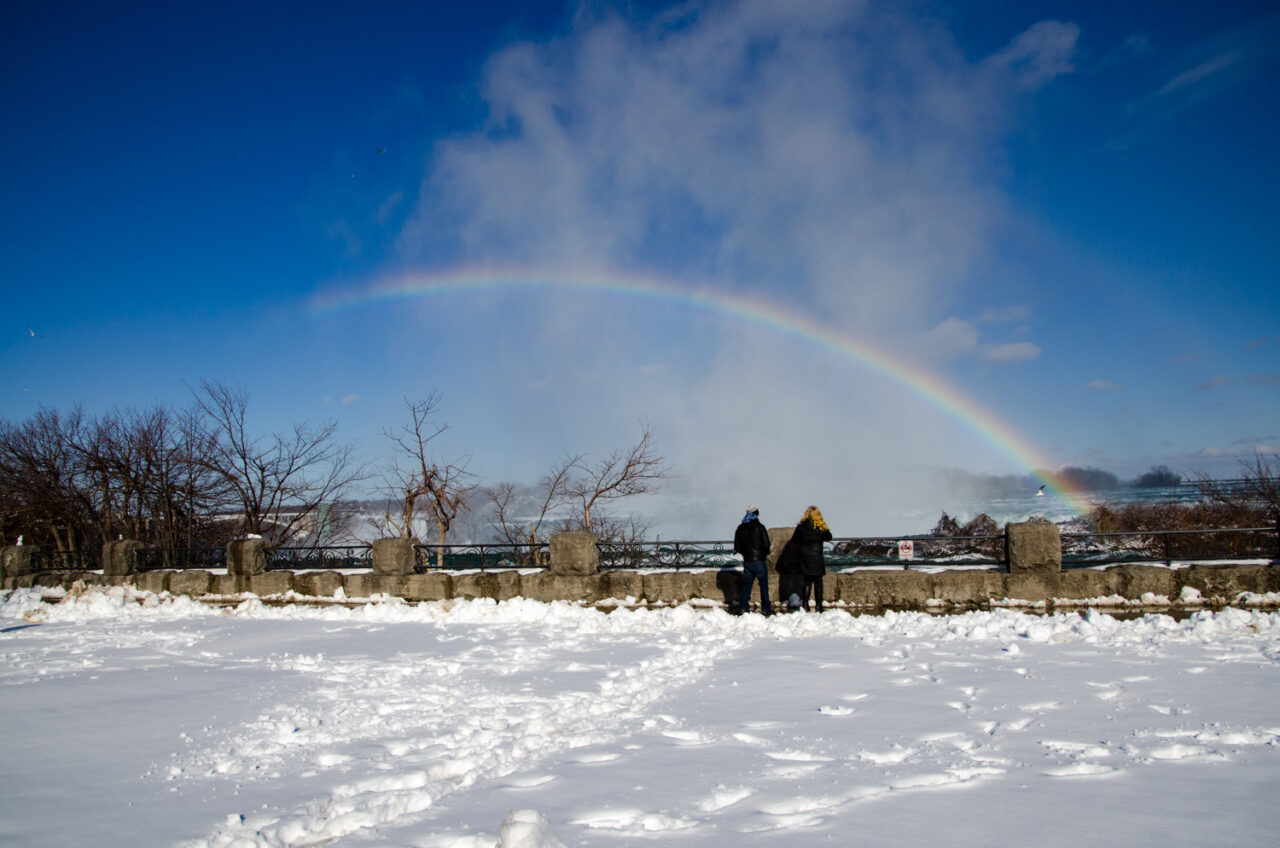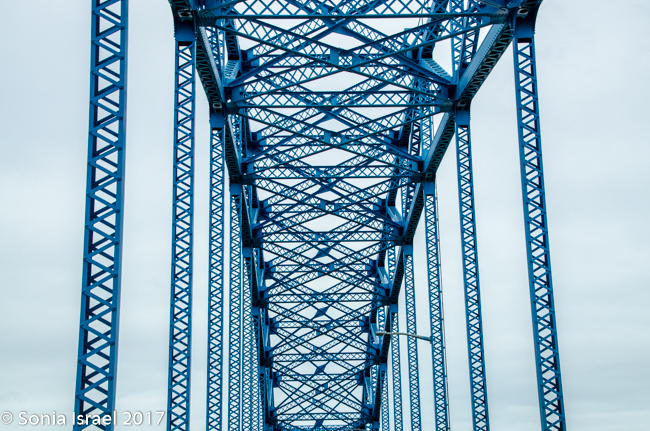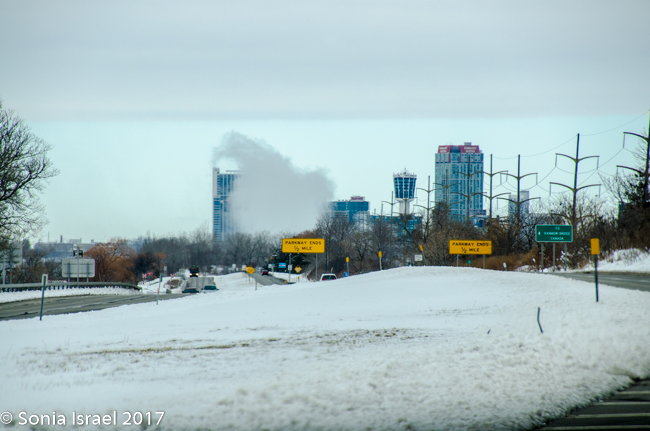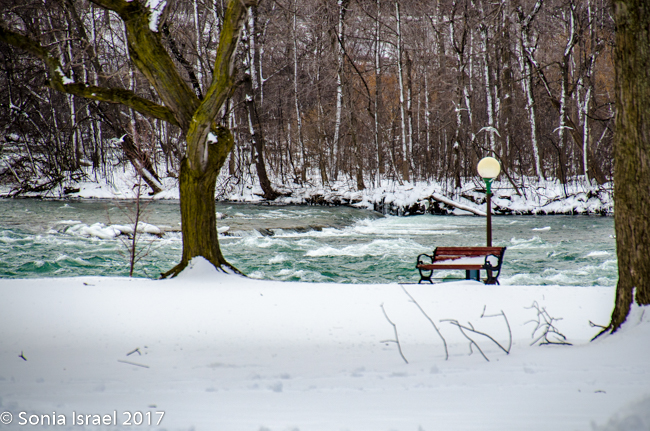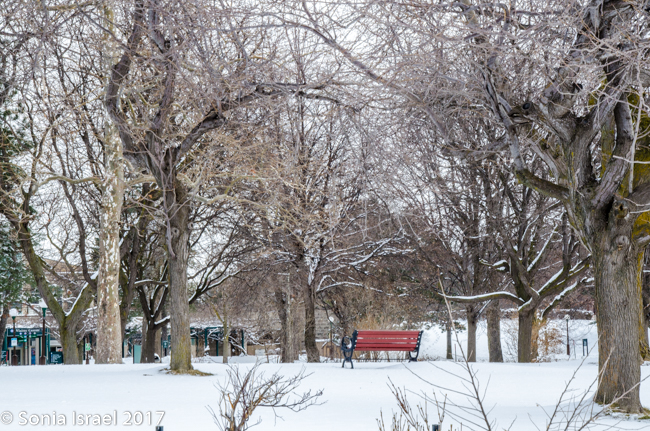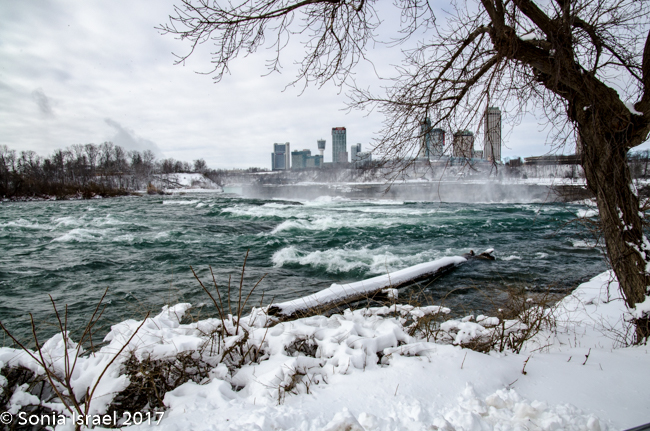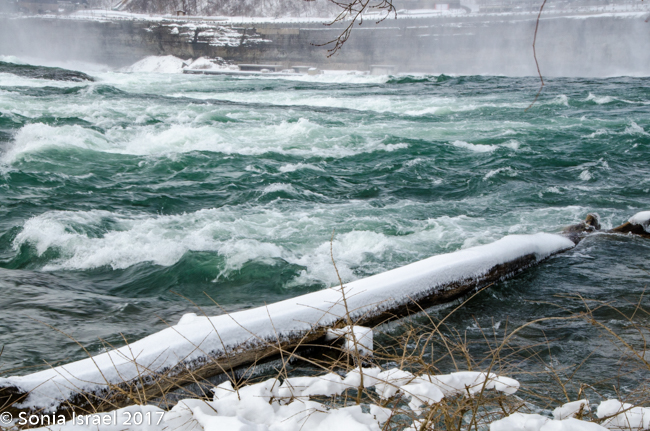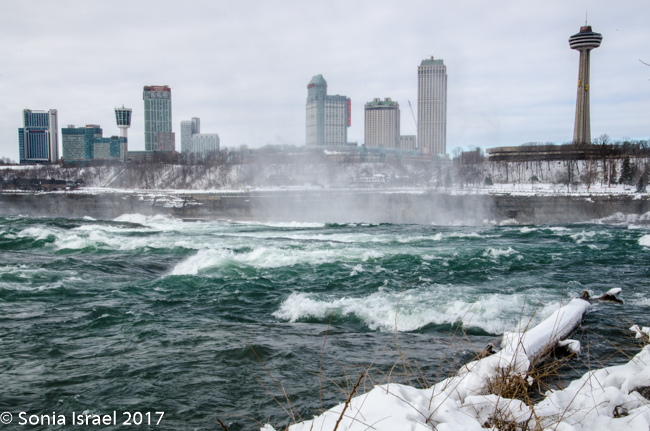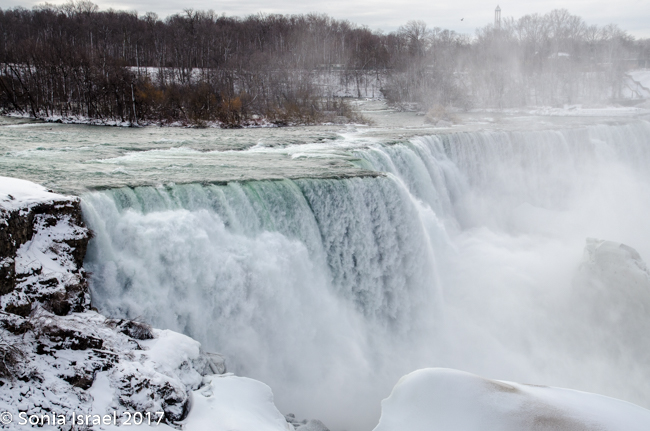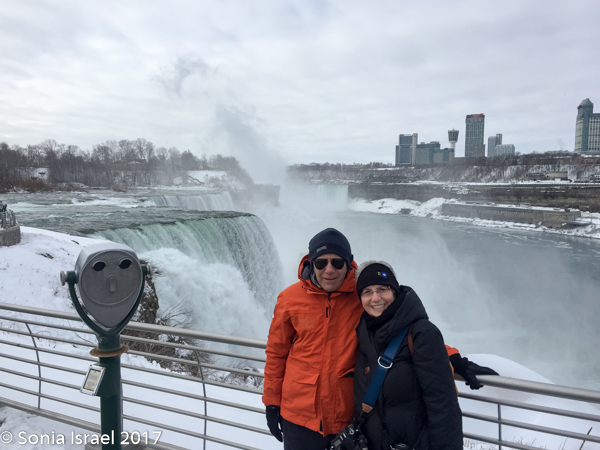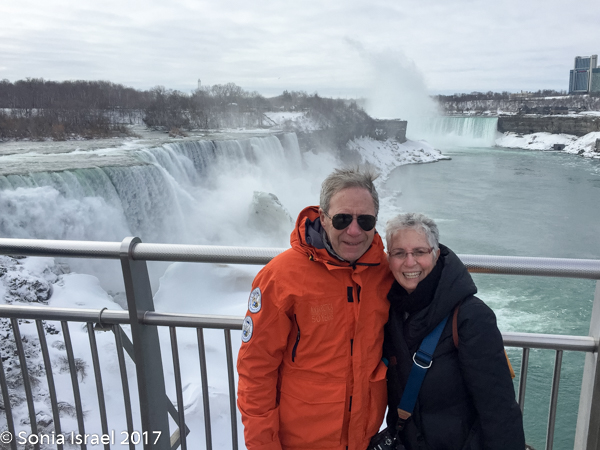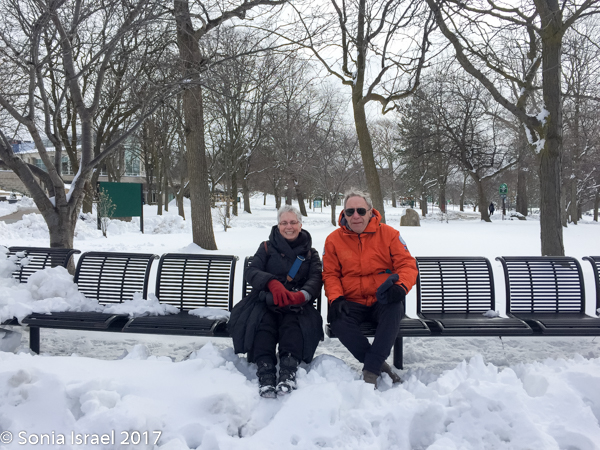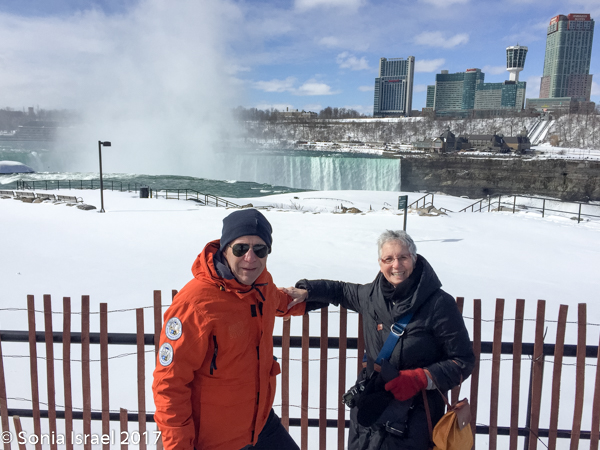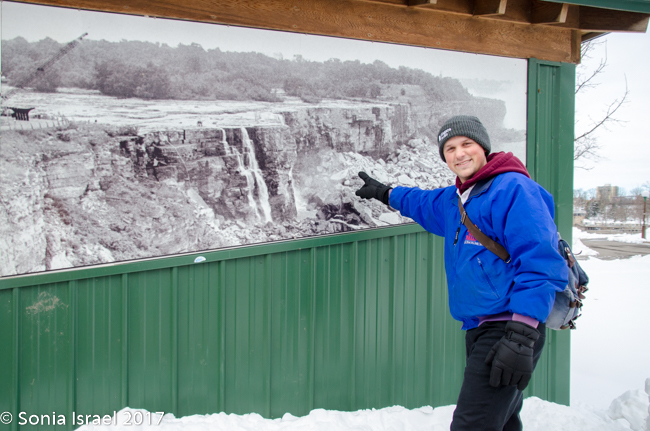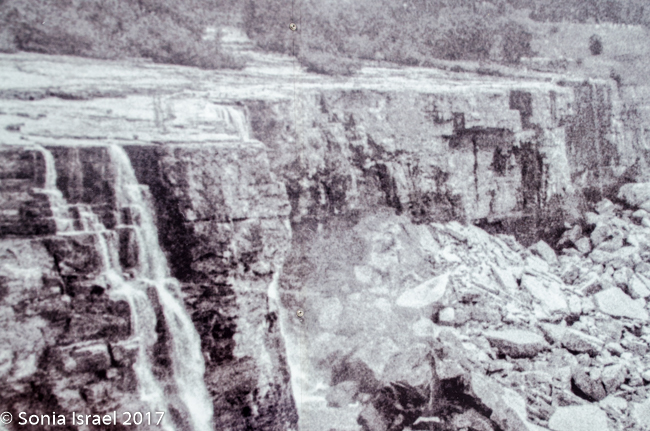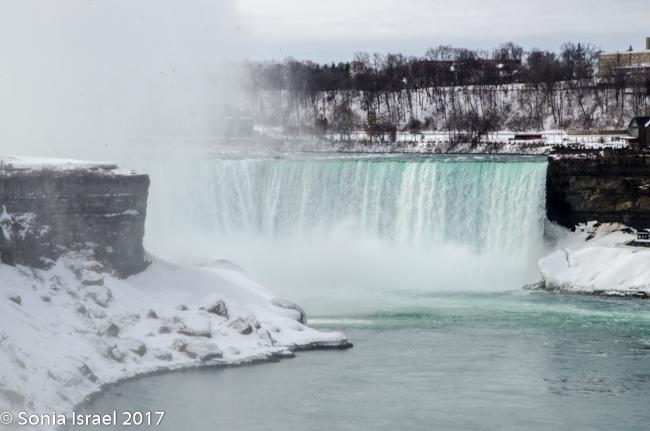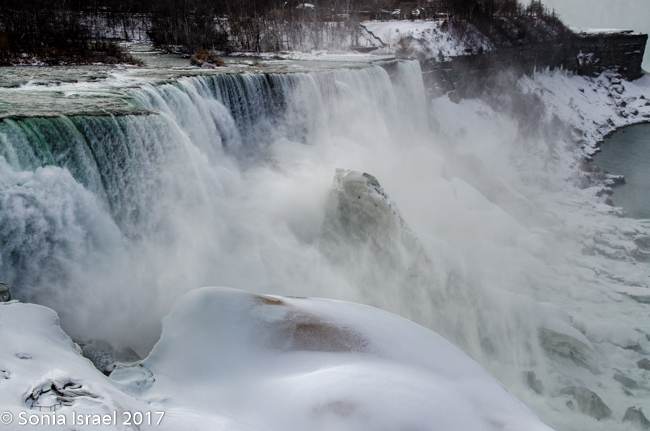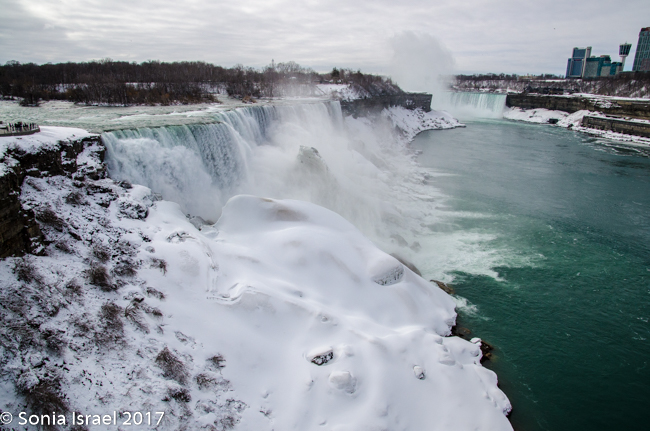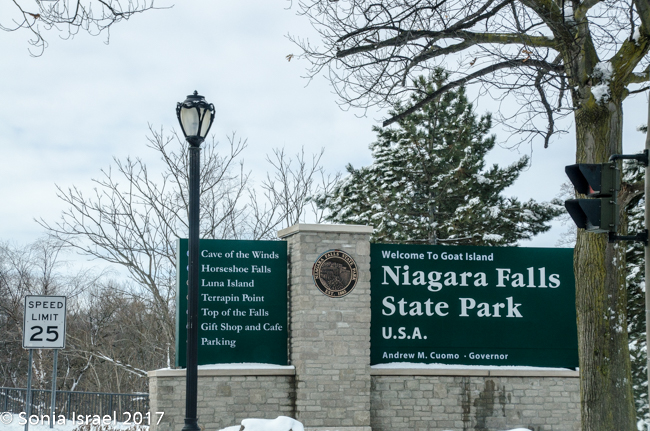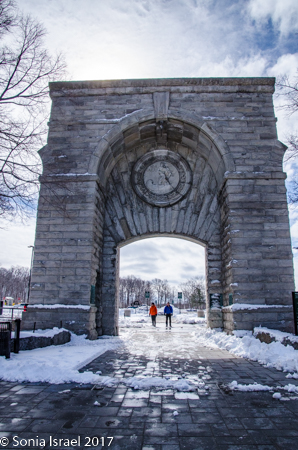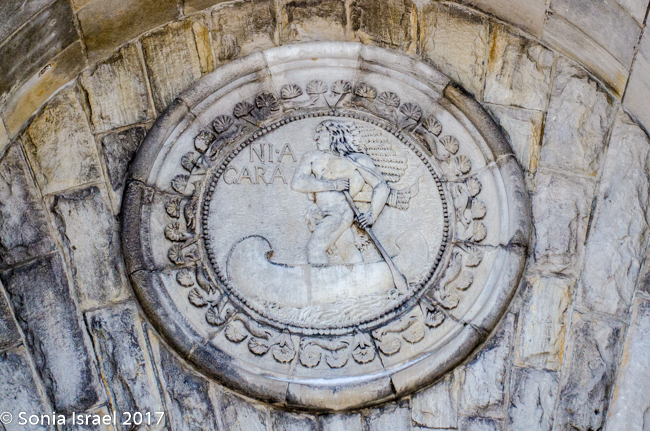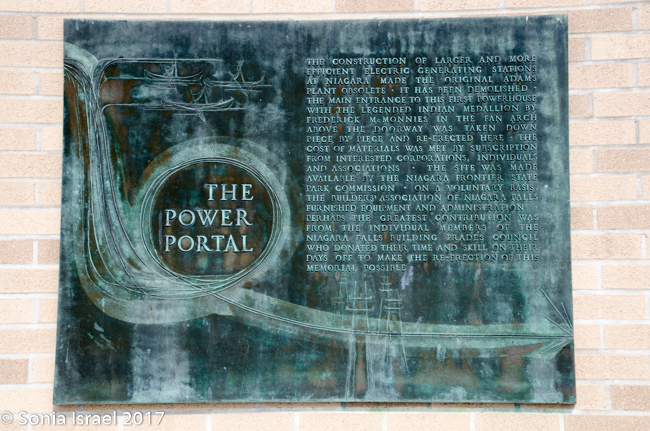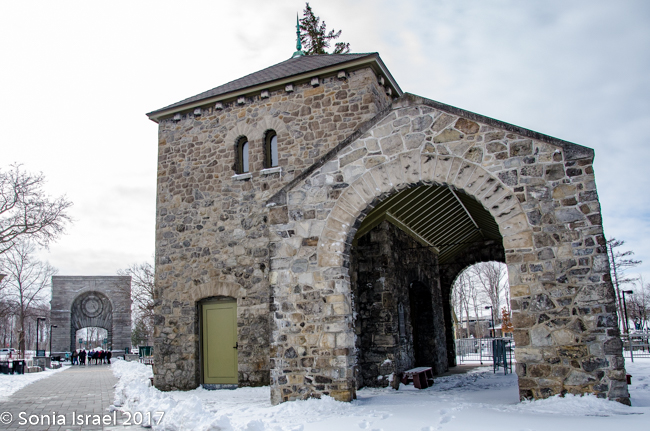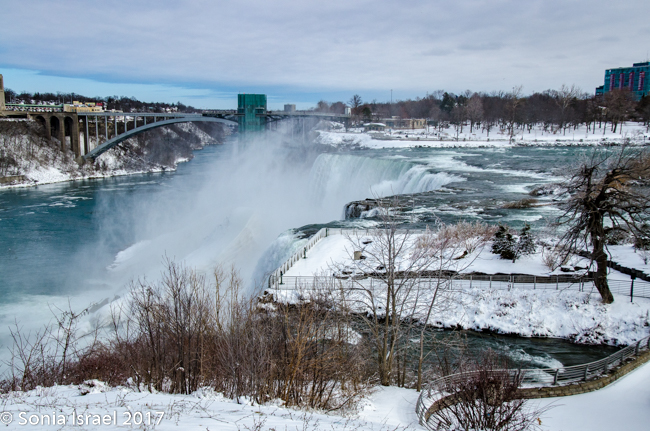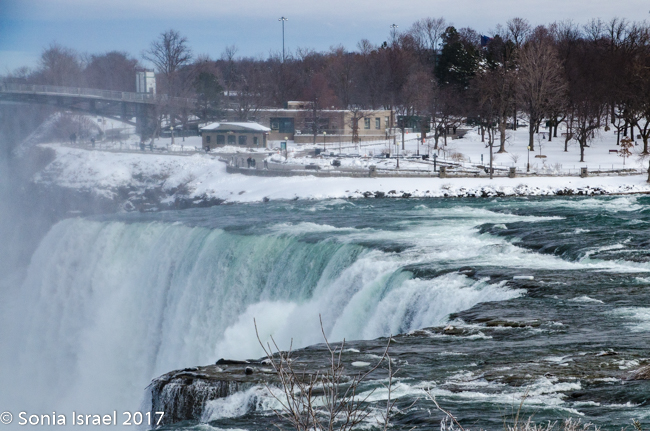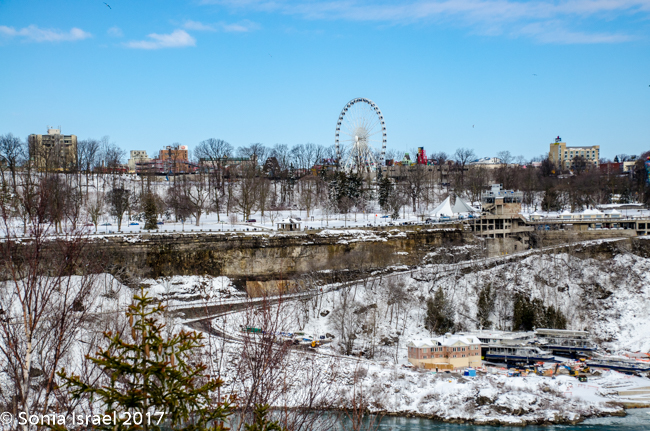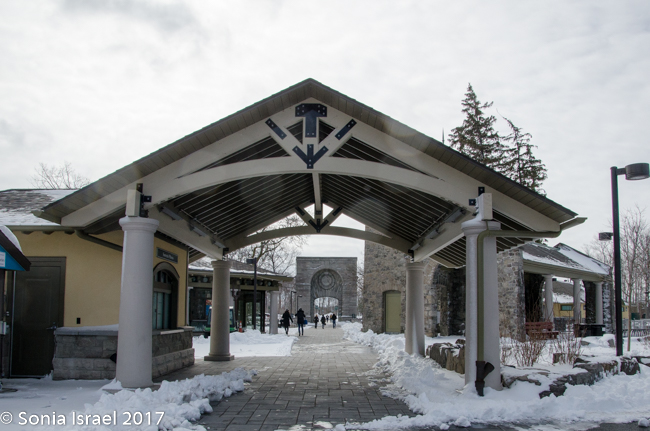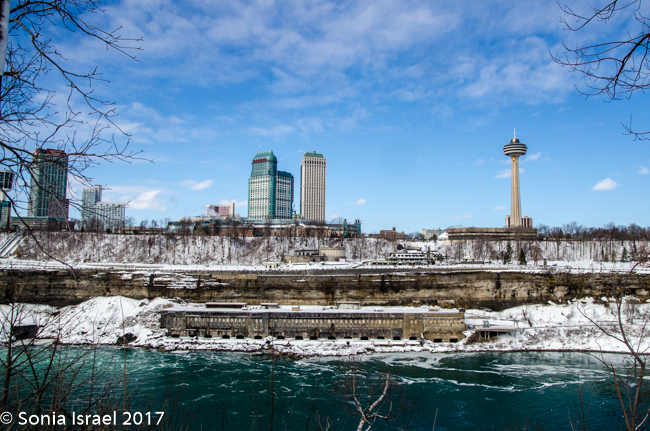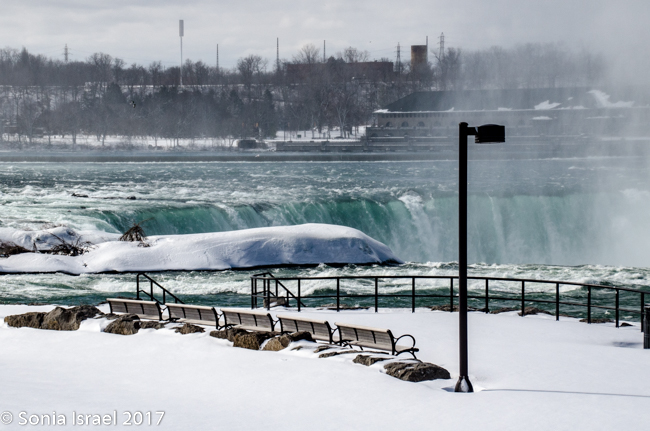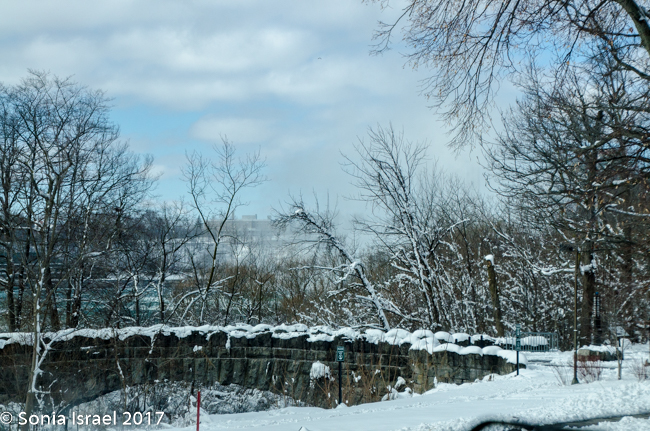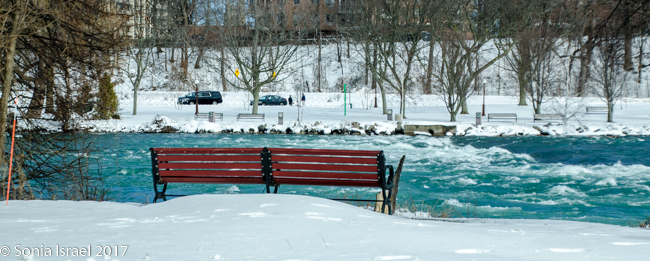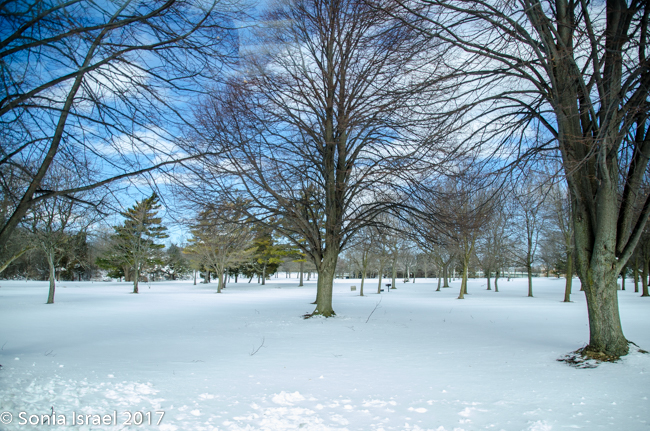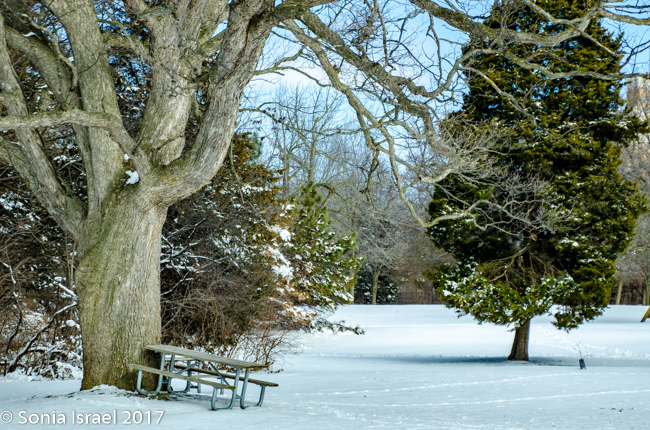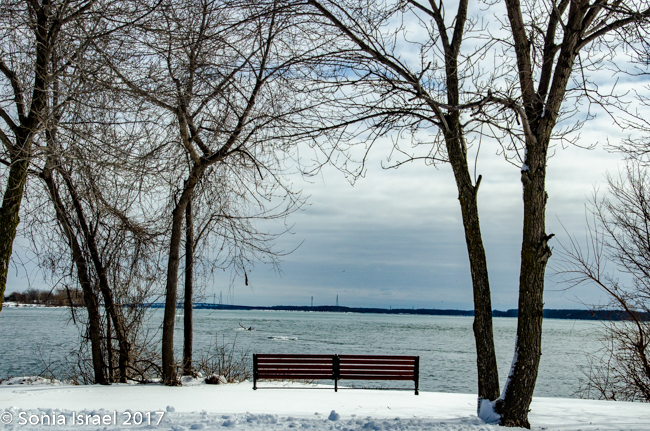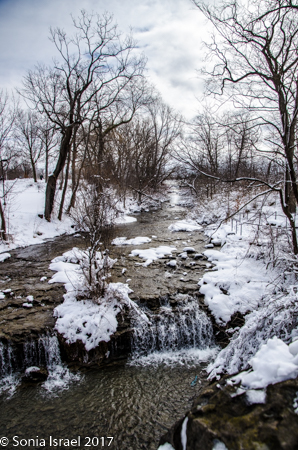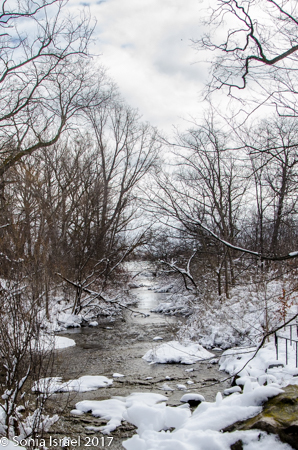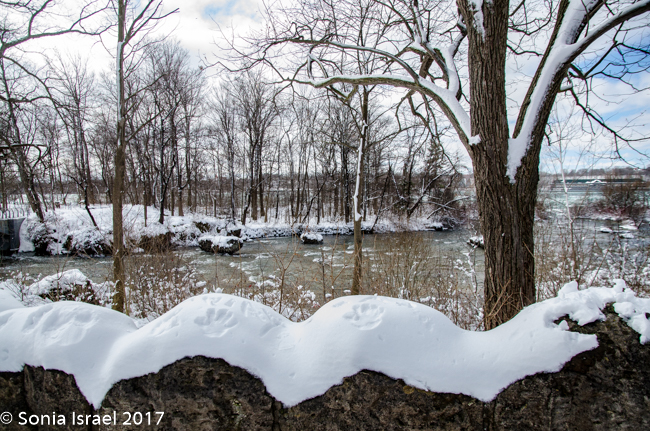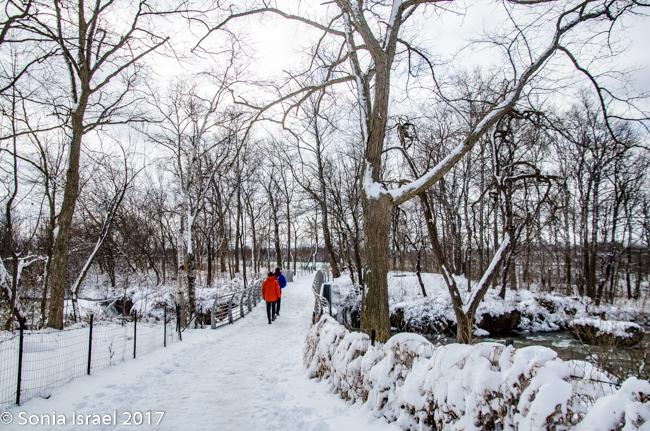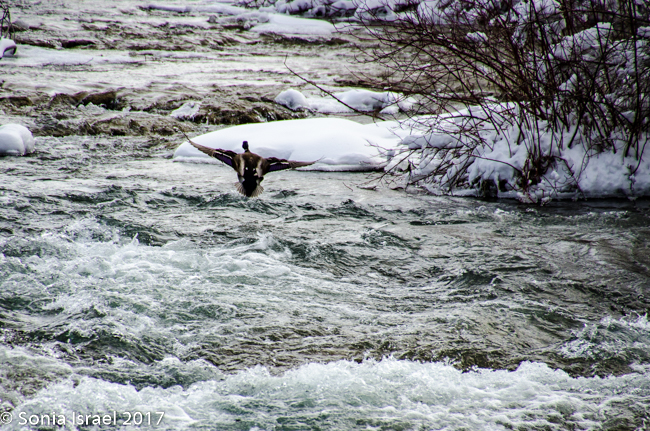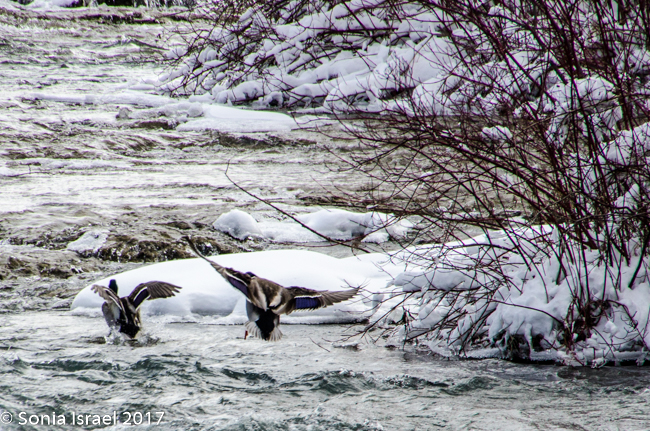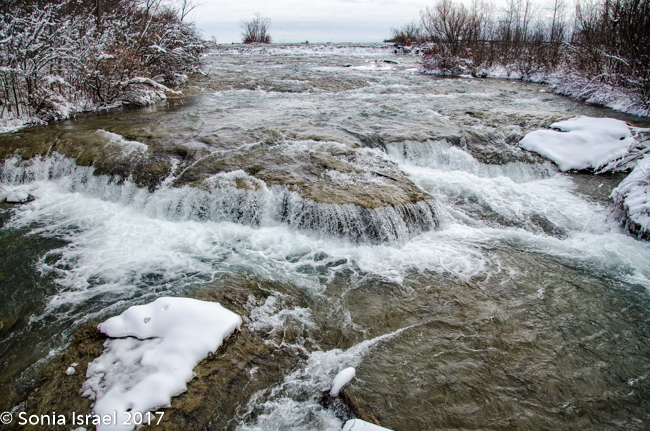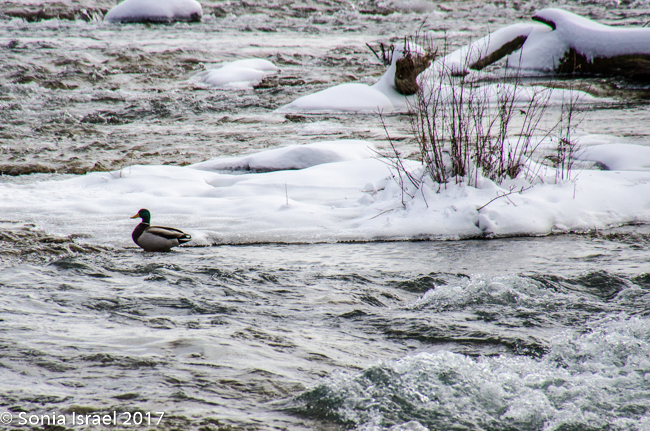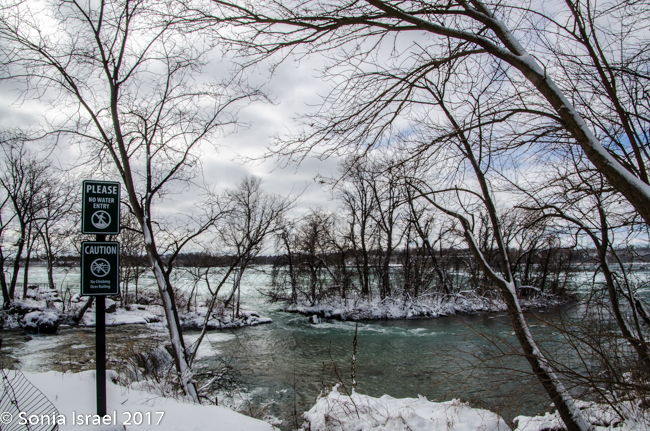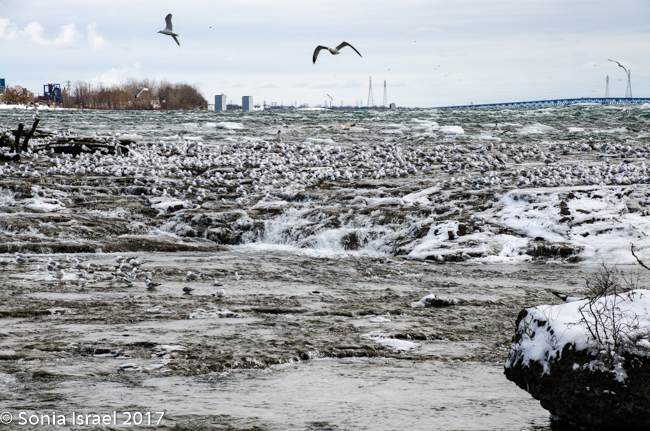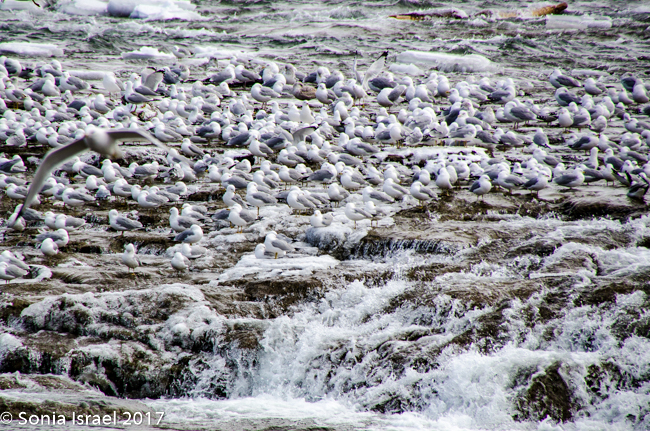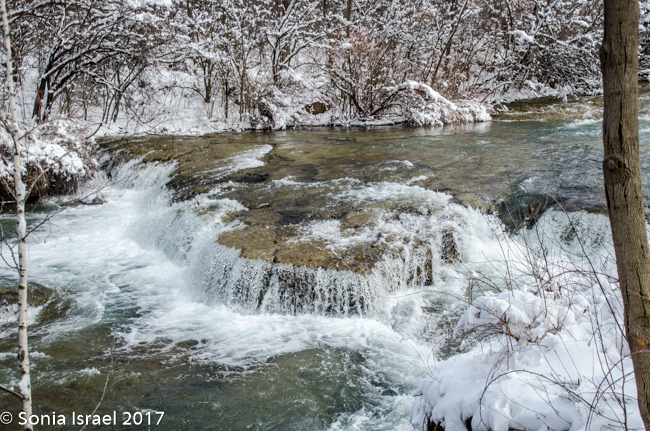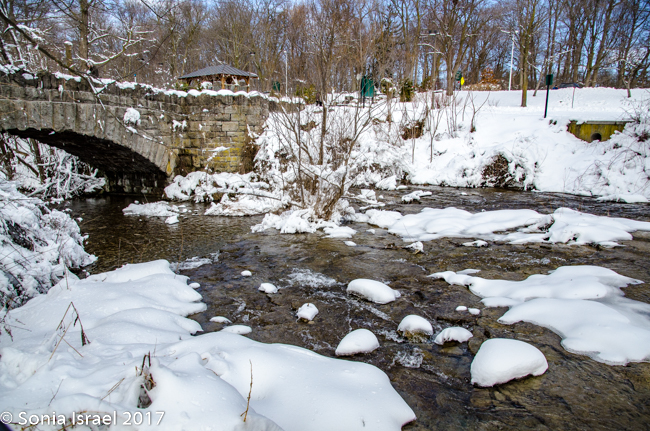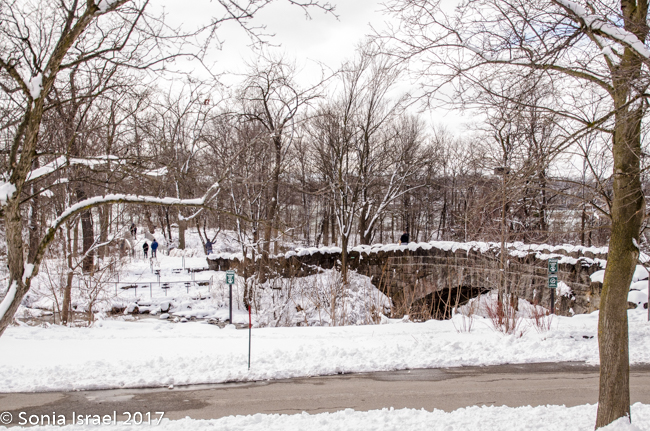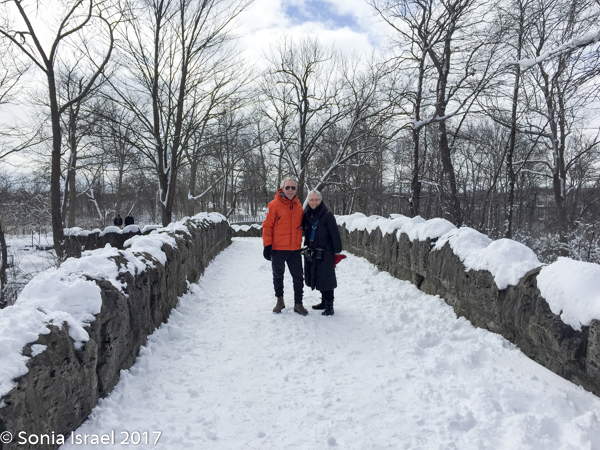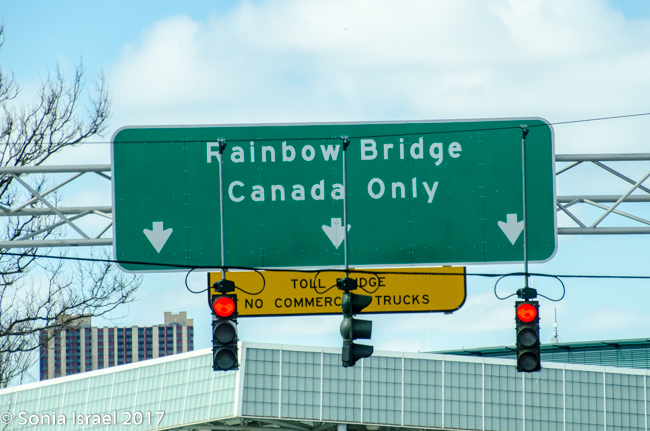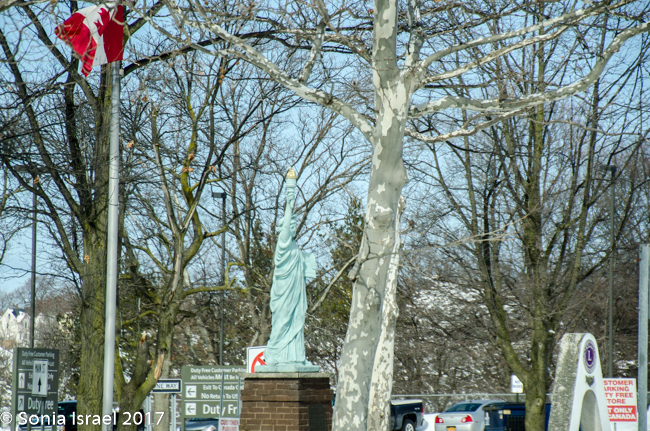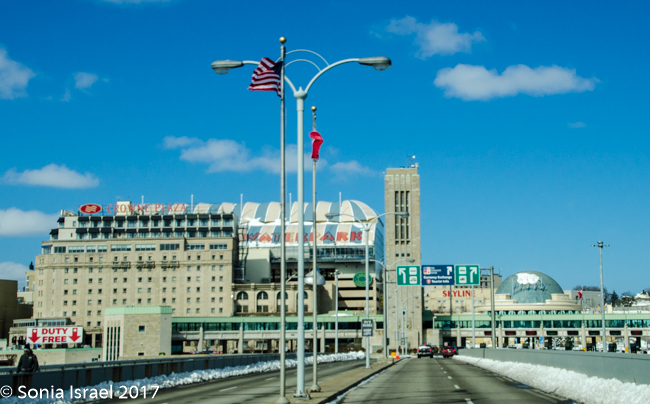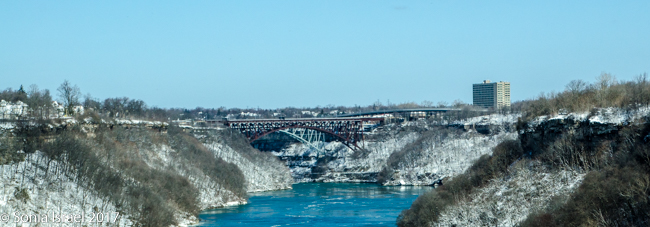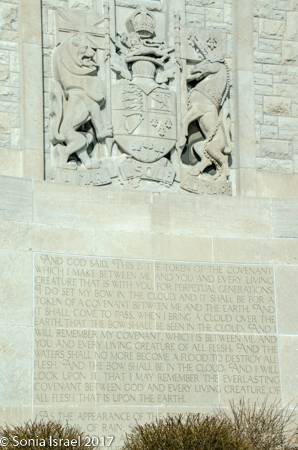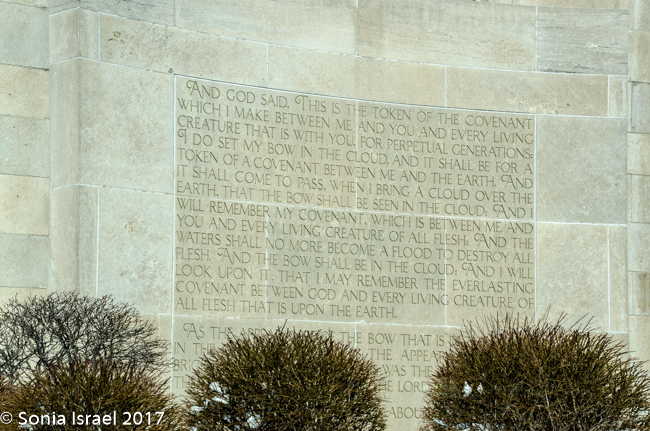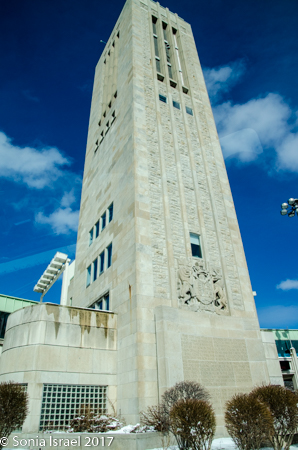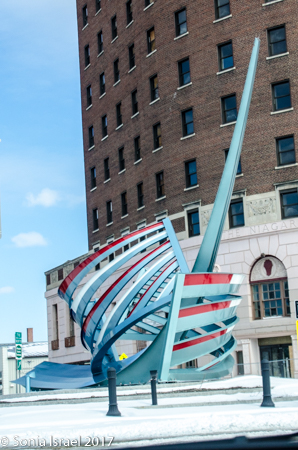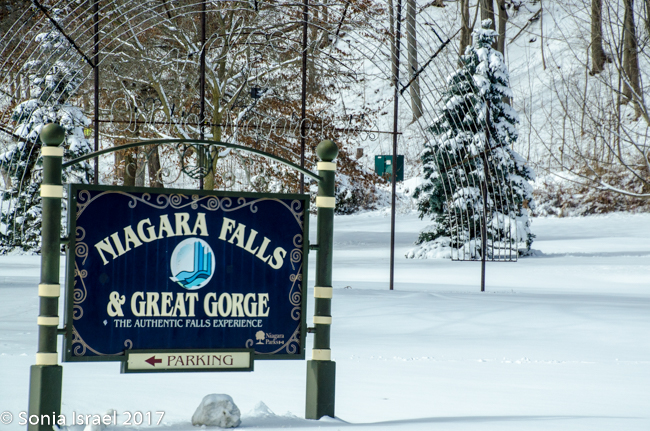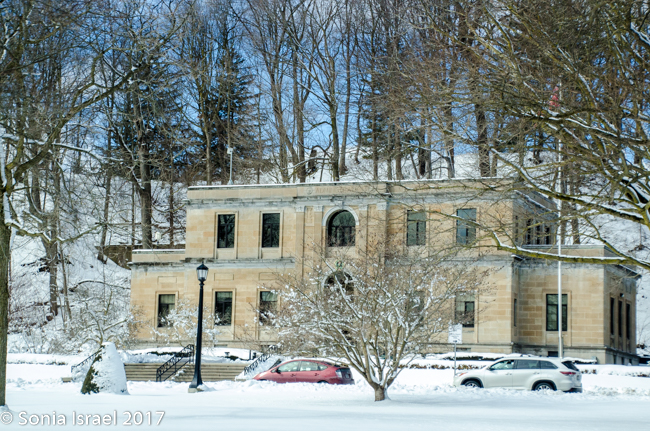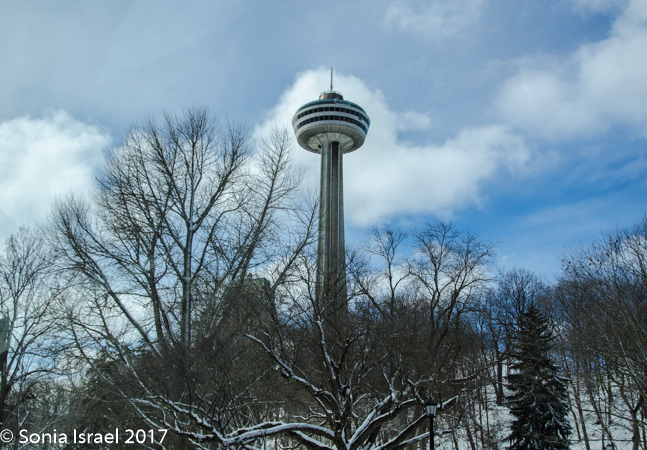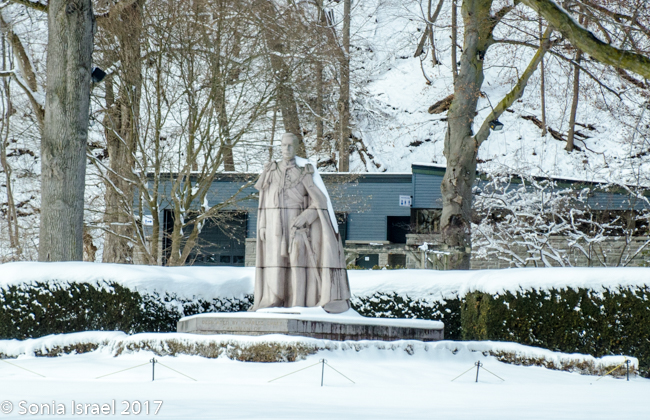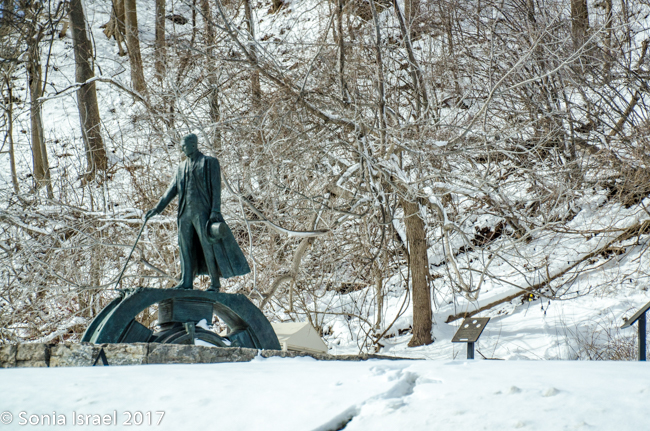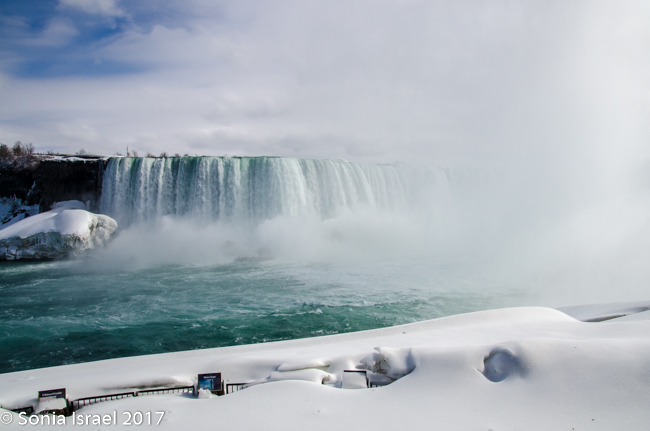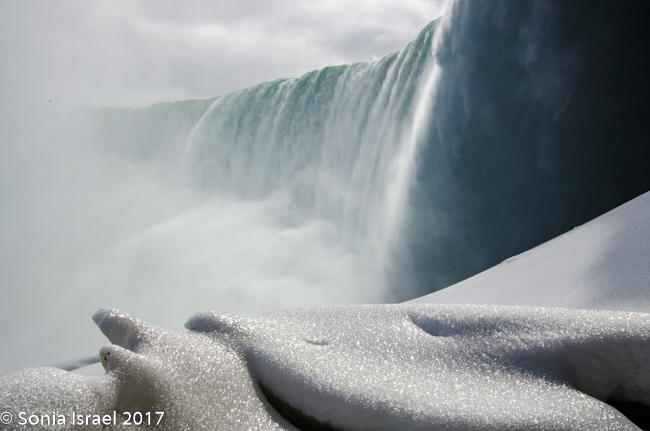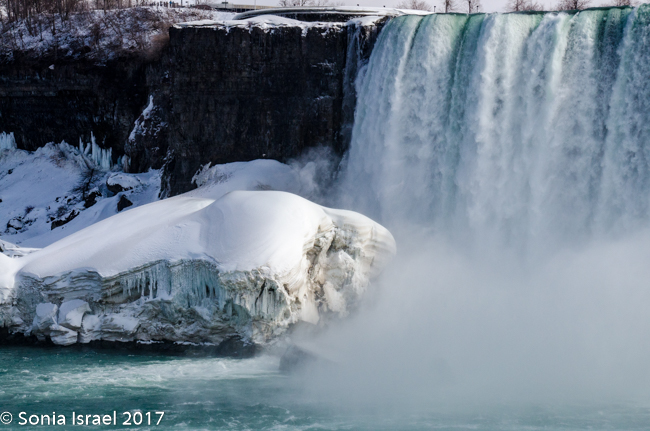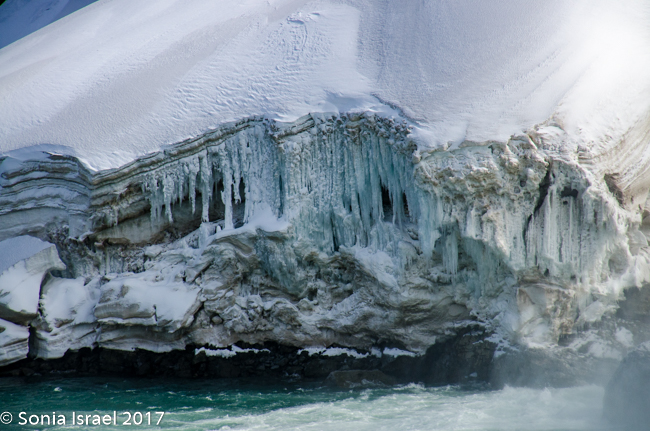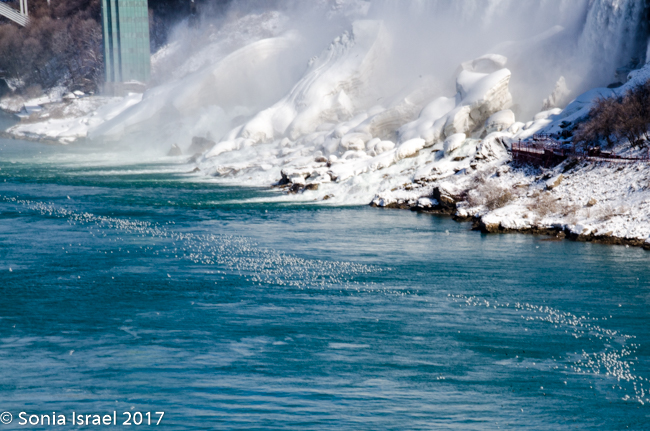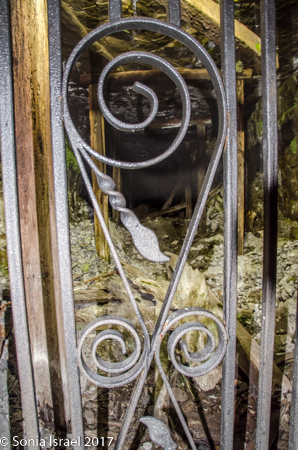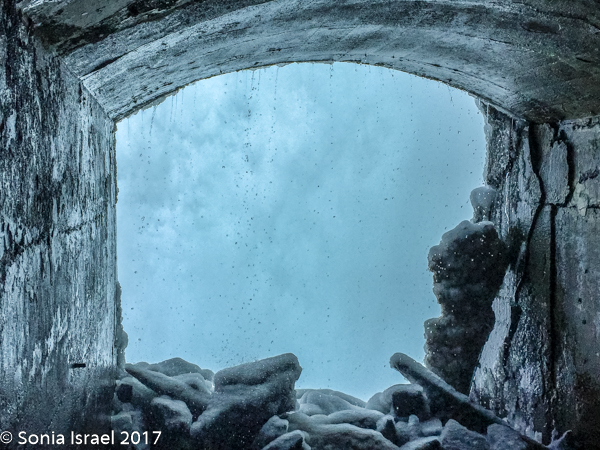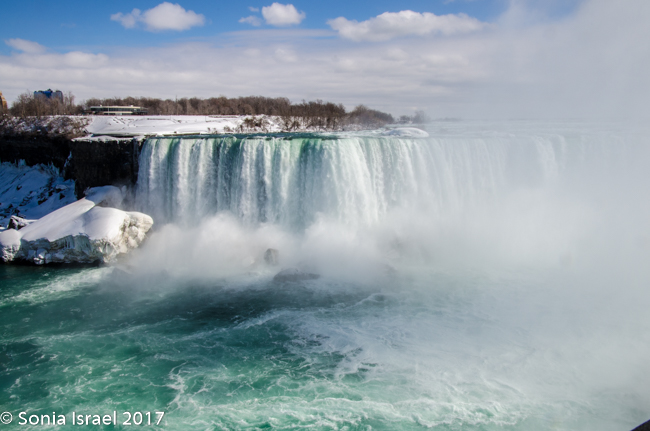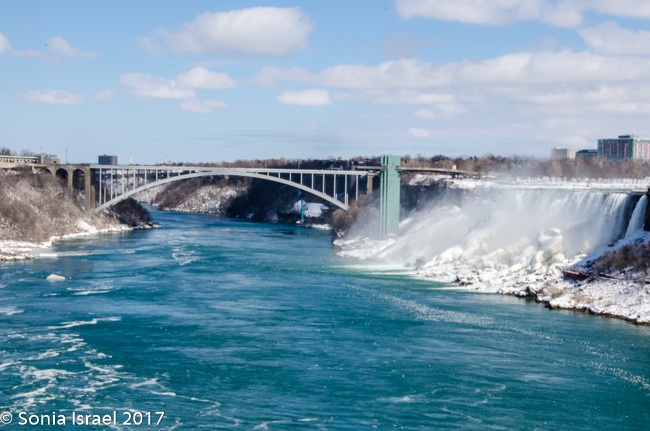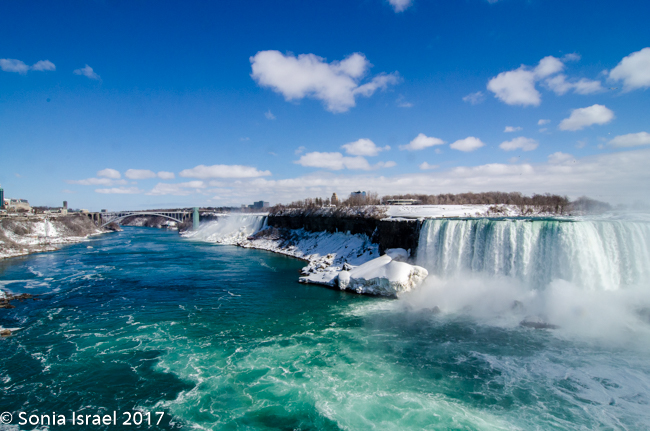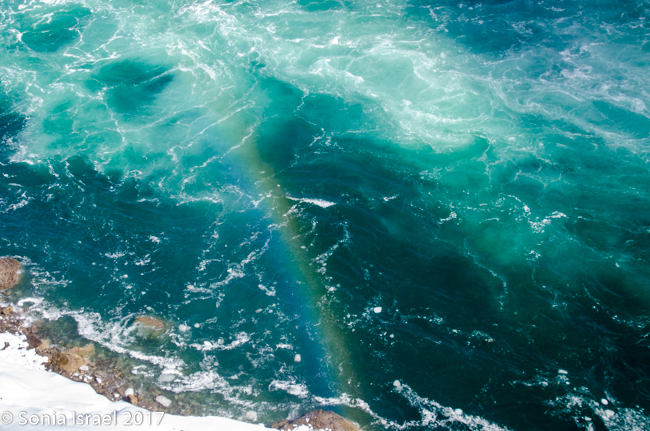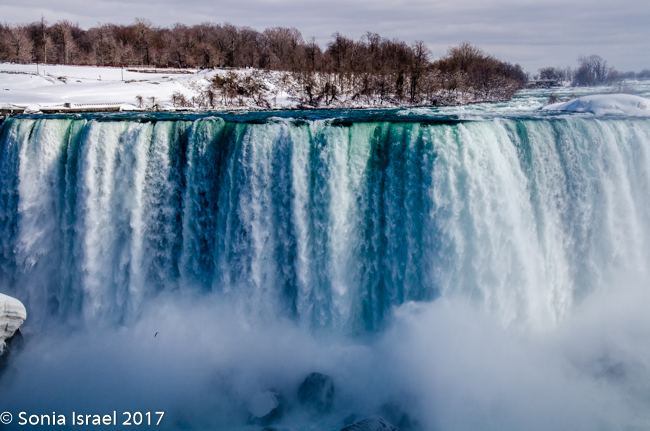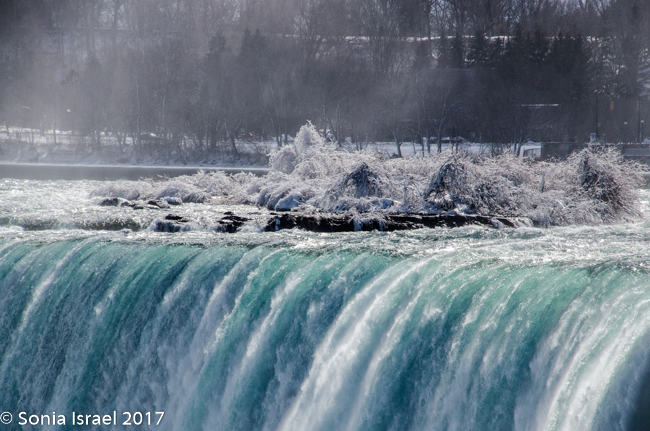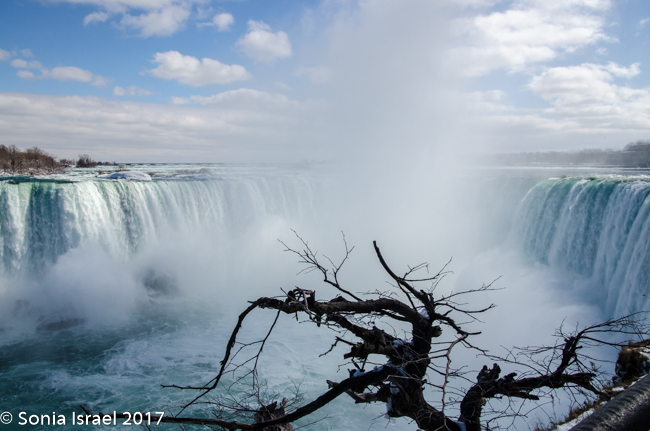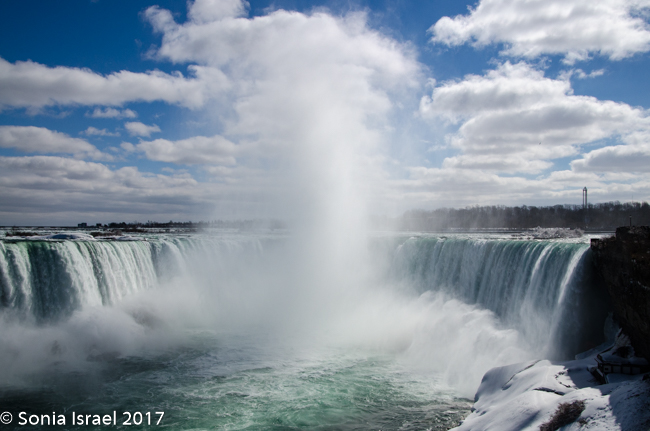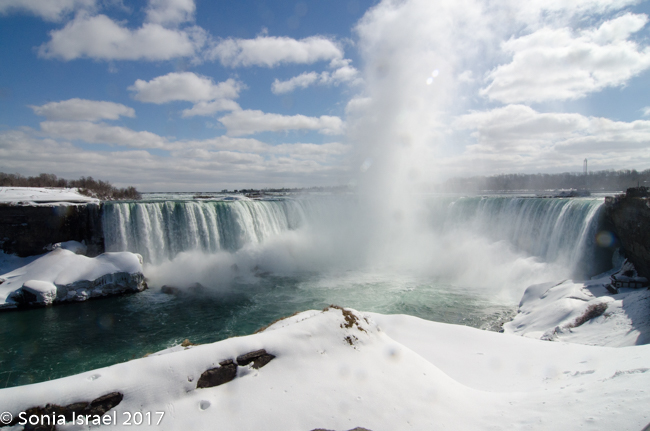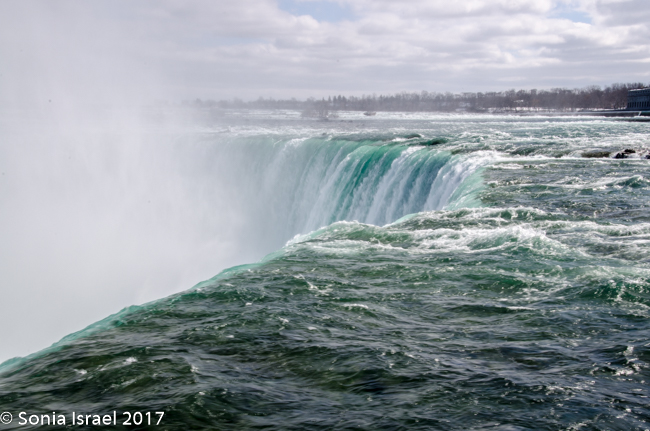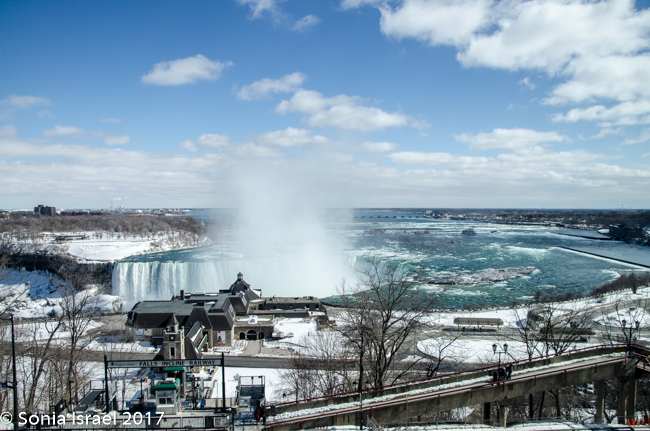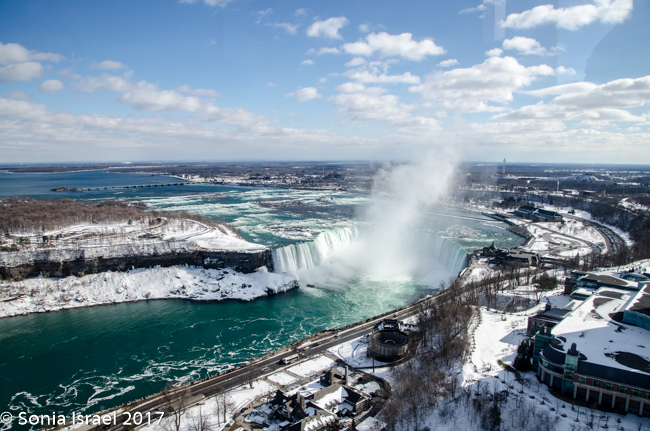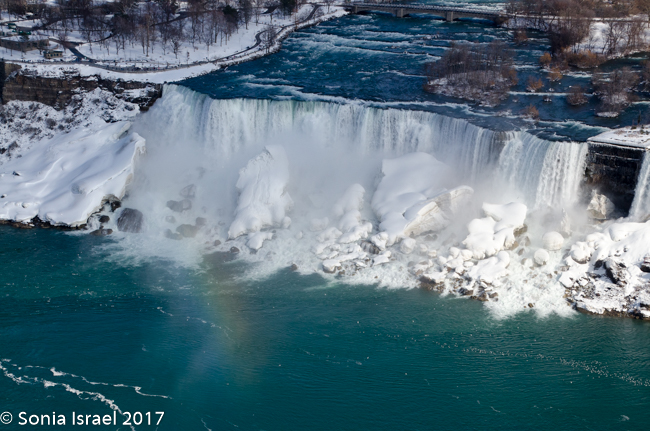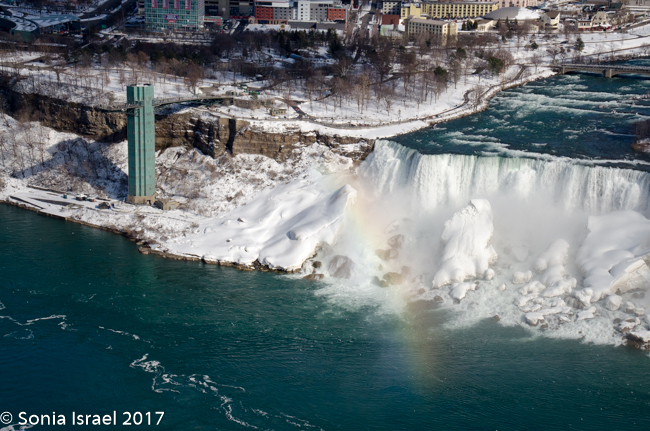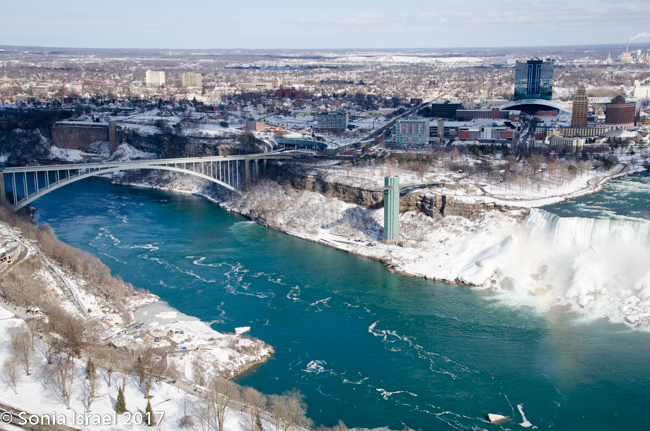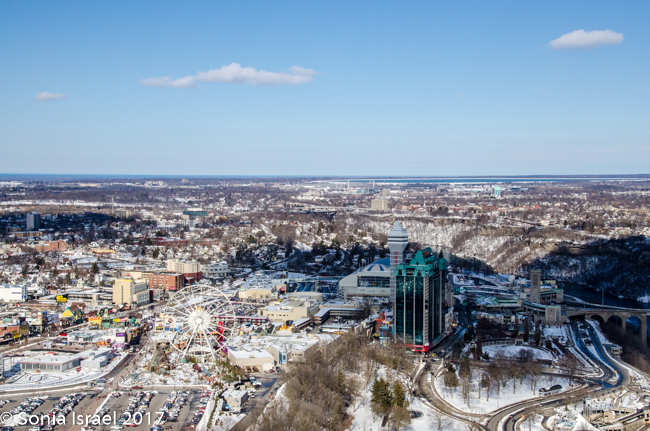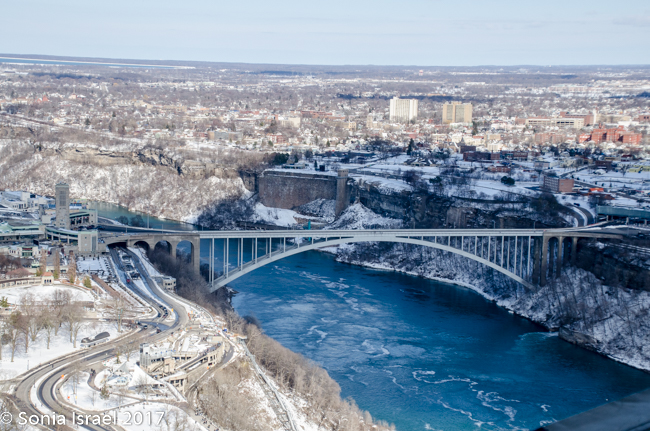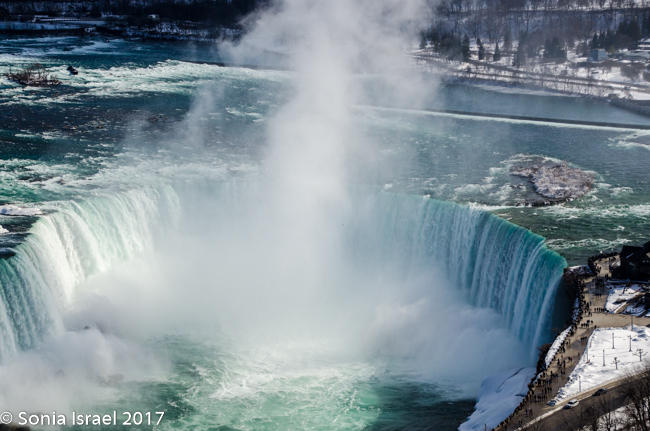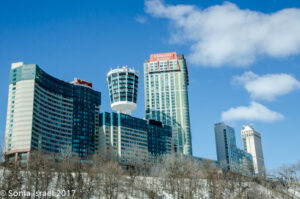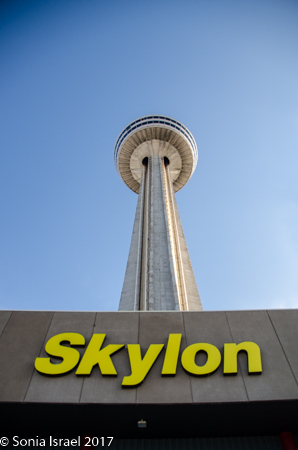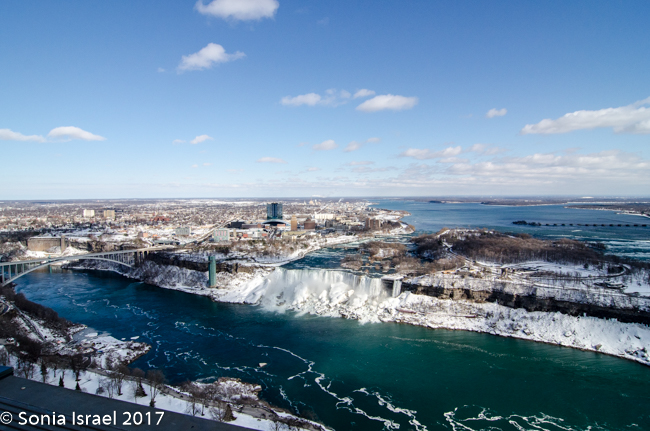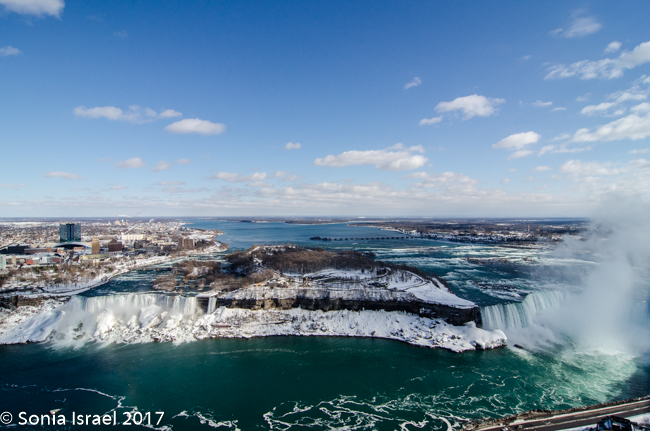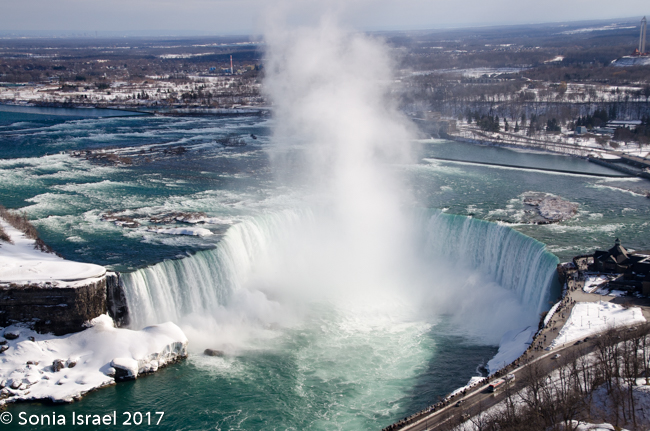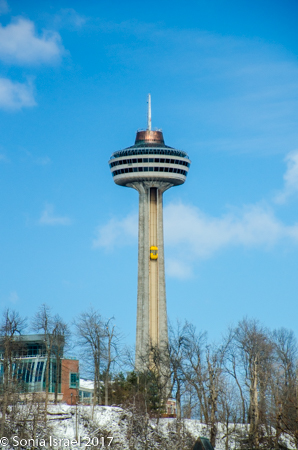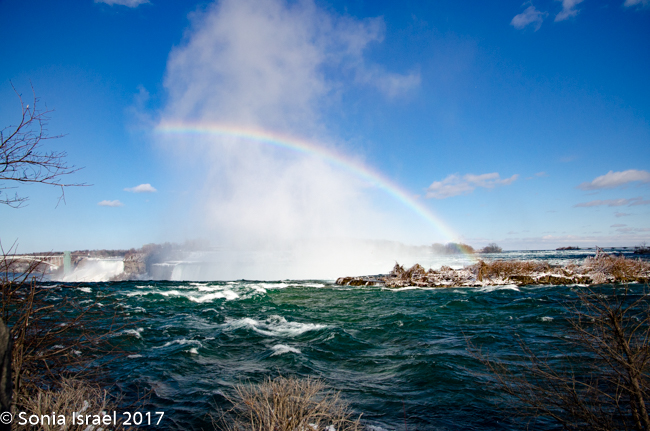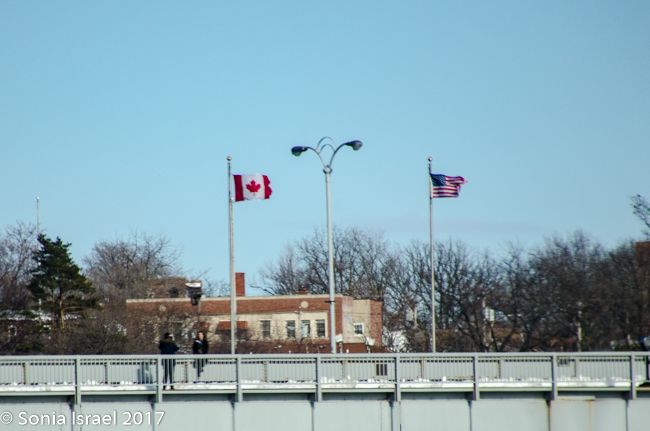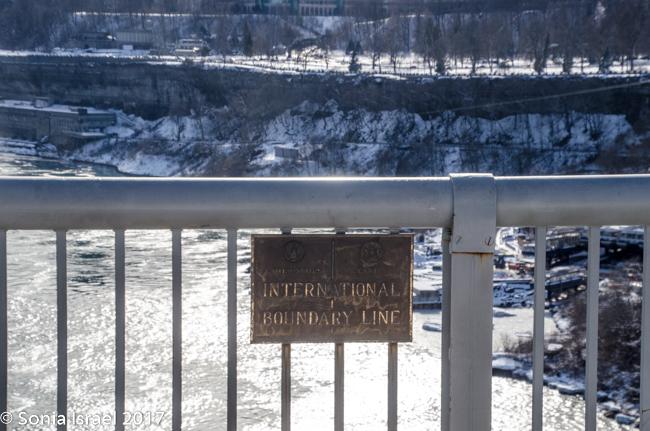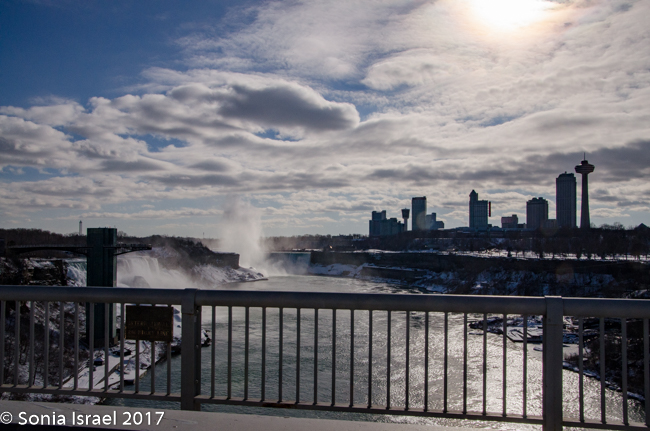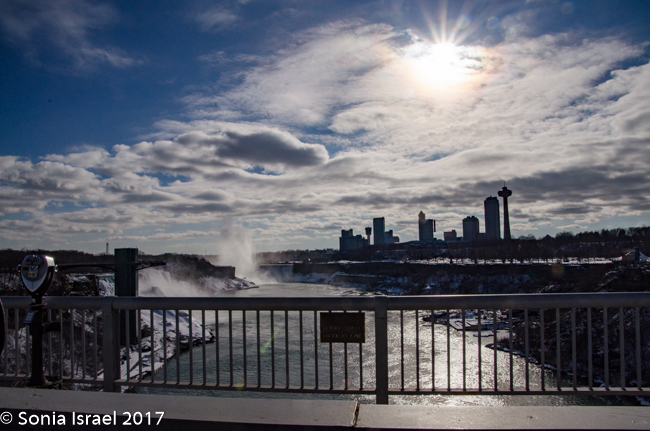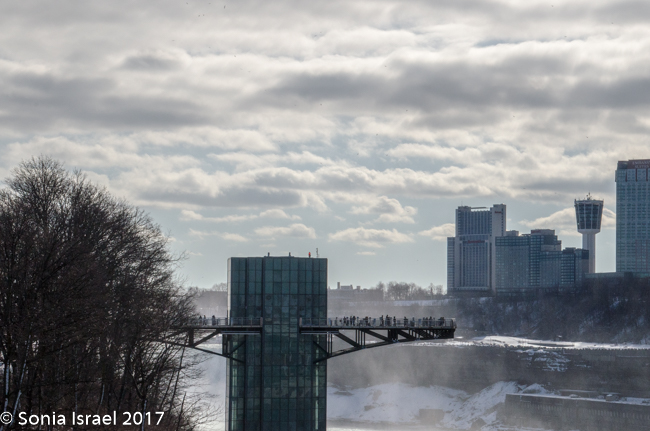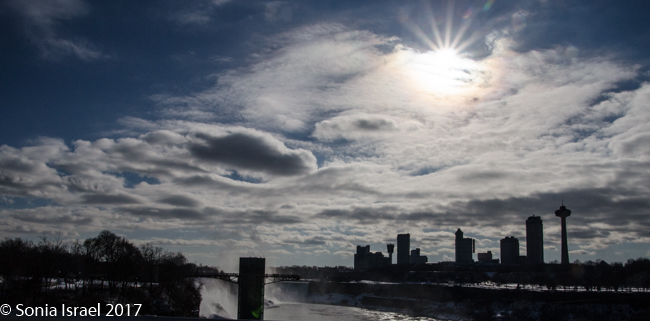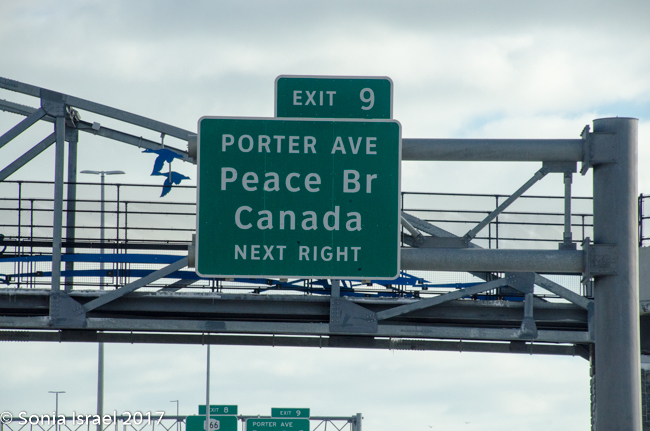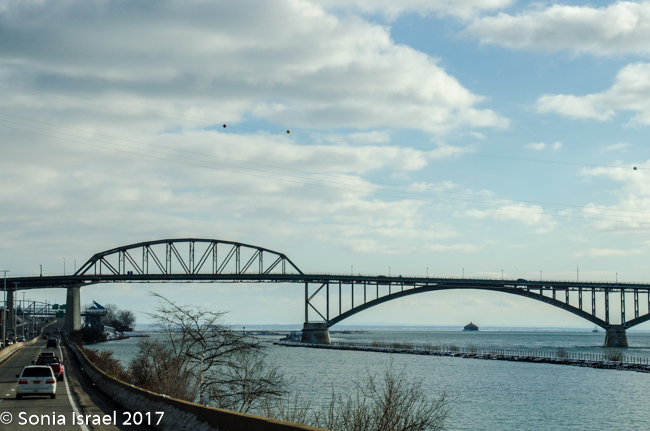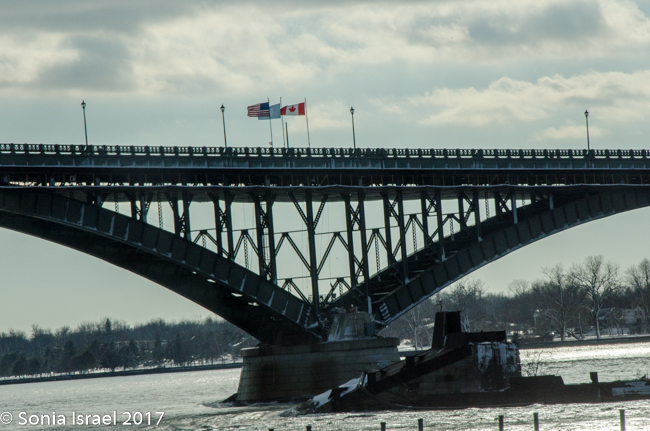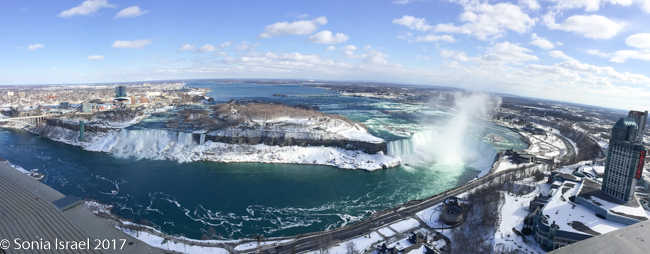Niagara Falls
We found ourselves in Buffalo for a few days for business, so we thought, “What a great opportunity to visit Niagara Falls,” a place known for its beauty and power. If you follow my blog, you know we were in Iguazu Falls in October, so now we could add another fabulously famous fall to our bucket list. Both Andy and I have been here before, but as young children, so we had little memory of it. My only memory came from a photograph of me in a raincoat and hat on the Maiden of the Mist.
But this is winter, so there would be no chance to replicate that pose.
Over the Falls Tour Company
We decided we did not want to drive, so we arranged with the Over the Falls Tour Company for a private day tour. It was so easy to have them pick us up at our hotel in Buffalo, drive us around to all the important sights, take us to lunch and drive us back. Perfect. Easy. And our guide, Caleb, was fabulous. Knowledgeable. Friendly. Polite. The best way to spend the day. Caleb had to pass two tests to become a guide – one in the US and one in Canada. Plus getting licensed to drive a bus etc. He does this full time and it was clear that he is passionate about his job and about people. I asked him if he ever gets tired of the falls (the same question I asked Rodolfo in Iguazu), and Caleb answered: “Each day is different because the people are different.” He said he loves seeing the falls anew each time through his guests’ eyes. I loved his answer.
Caleb arrived early to get us and but told us to take our time. But we were ready to hit the road. We were in a Yukon SUV and in the back seat was a basket with water and a box of chocolates – wrapped in a bow. I am often given water and mints, but never have I been given a box of chocolates (caramel chocolates yet – how did he 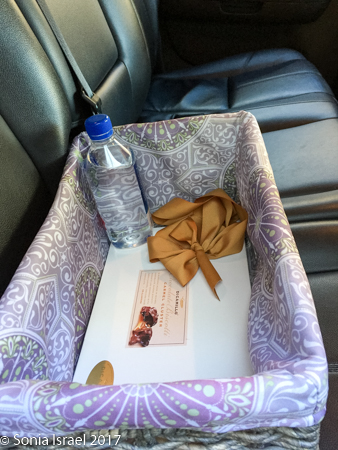 know my favorite?) by a guide. He immediately won points with me. I told him the only other thing he had to do to make it a perfect day was to find me a rainbow.
know my favorite?) by a guide. He immediately won points with me. I told him the only other thing he had to do to make it a perfect day was to find me a rainbow.
Although the chocolates were in the back seat, I opted to sit in the front seat where I could more easily take pictures along the way. We set off through downtown Buffalo to the road which ran along the Niagara River on the way to the falls. We drove over the blue Grand Island Bridge, which as the name implies, connected Buffalo with Grand Island, filled with luxury homes which are expensive for this area, around $300.000. There was
once a proposal to build Disney World here rather than in Florida. Imagine how that would have changed Niagara Falls!
As we continued driving, we could see the mist from the falls in the distance.
Where does the name Niagara come from?
We learned several things right away. First, where did the name Niagara come from? One theory is that it comes from the Iroquois town called Ongniaahra, meaning “point of land cut in two.” They believed that the Thunder Spirits were found in the mist of the falls. A second theory is that it is derived from the Niagagarega Native Americans. A third theory is that the name is Mohawk, onyara (pronounced o-ne-au-ga-rah, and means “the neck” meaning the neck of land between Lake Erie and Lake Ontario. We drove along the Niagara River which drains Lake Erie into Lake Ontario. Caleb told us that the Great Lakes hold 20% of the worlds fresh water.
Niagara Falls State Park
We entered the Niagara Falls State Park, the first State Park in the US and designed 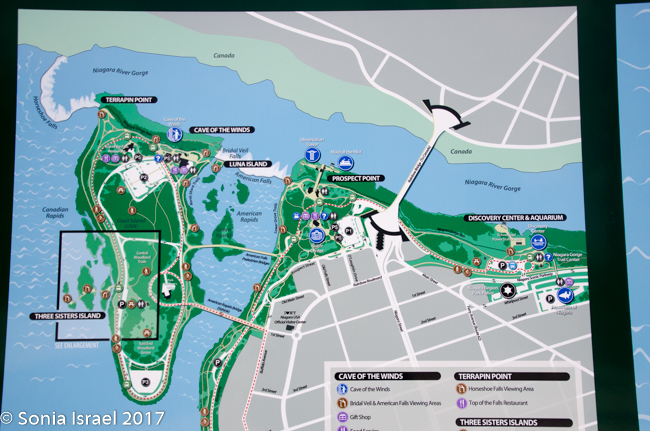 by Olmsted who also designed Central Park. We parked our car in an empty parking lot. Winter is one of the best times to come if you don’t want to fight the crowds. Caleb said the best times are fall, summer and winter. Spring is actually not so great as the water is very muddy and it is more rainy. Summer is warm, but full of crowds and long lines.
by Olmsted who also designed Central Park. We parked our car in an empty parking lot. Winter is one of the best times to come if you don’t want to fight the crowds. Caleb said the best times are fall, summer and winter. Spring is actually not so great as the water is very muddy and it is more rainy. Summer is warm, but full of crowds and long lines.
And winter – we hardly saw another soul. The ground was covered in snow. Tree branches were covered in snow. The river was frozen in parts. It was ethereal. It was quiet. The sun peeked through the clouds and made the snow glisten.
Observation Tower at Prospect Point
We walked over to the Observation Tower at Prospect Point, but it was not open yet. So we walked around and admired the first of the three falls, the American Falls and the amazing mist above them. The American Falls are 1,060 feet wide and vary between 70-100 feet high. The reason for this variation has to do with the giant boulders at the base. We kept walking around to check out the rapids leading into the falls. The water was spurting and turning over itself and over the rocks. There were tree trunks and branches, covered in snow, sticking out at odd angles. Snow covered everything. And sea gulls were everywhere. There are about 40,000 seagulls here. They come to fish as the fresh water fish from Lake Erie get caught in the rapids and go over the falls. Then they hit the bottom, the gulls are there to eat them.
And then the water stopped
Caleb stopped us at the side of the closed snack bar to look at an old photograph of when Niagara Falls went dry. Dry, you ask? Yes. For several months in 1969, the torrent of water rushing over American Falls was reduced to little more than a trickle. As I mentioned above, the American Falls has an immense pile of rocks (called talus) at the base, which resulted from natural rock slides over the years. In the 1960s, engineers were worried that more rockslides would completely erode the falls. So, to study the geological composition of the falls in hopes of forestalling their potential destruction, the falls were “dewatered” for five months. For three days in June of 1969, more than 1200 trucks dumped close to 28.000 tons of rocky fill into the dam upstream of the falls, thus diverting the flow of the Niagara River away from the American Falls towards the Horseshoe Falls. This gave the engineers the opportunity to study the rocks. And it gave tourists a chance to scurry around collected coins that had been tossed over.
There are plans to silence the waters again in 2019 when the Niagara River will again be diverted for about 9 months, this time to allow for the replacement of two 115-year old stone arch commuter bridges that lead to Goat Island.
But what most people don’t realize, is that between 9pm and 8am every night, half of the water (50%) going over the falls is diverted to produce electricity at hydro plants deep below the falls. This is done via the International Control Dam with movable gates upstream from the Horseshoe Falls. During the winter, another 25% is diverted so that only 25% of the water that could, actually flows over the edge. In 2005-2013, a tunnel system (the Niagara Tunnel Project) was built which diverted the water and increased the power generated.
Maiden of the Mist
We were about to continue walking to Goat Island, but Caleb noticed that the Observation Tower was open so we walked back. On a summer day, the lines would have snaked back and forth, but we walked right in. This is also where people line up to ride the Maiden of the Mist. So, although the Maiden of the Mist was not operating, one can’t help asking, why is it called a Maiden? It comes from an old Native American legend about Lelawala, a beautiful maiden of the peaceful tribe of the Ongiaras. She was in love with He-No, the god of thunder who lived in a cave beneath Horseshoe Falls. But her father, the king, married her off to someone else. She decided she wanted to find He-No at all cost, and as she paddled a canoe onto the Niagara River,she was swept off the Falls. Luckily, He-No had been watching and caught her as she fell. It is said they stayed together after that and their sprits still live in the caves beneath Niagara Falls to this day. Lelawala is known as the original Maid of the Mist and when you see a rainbow, you are seeing her spirit.
There is a second legend as well. As mentioned above, Niagara Falls, or Nee-ah-gah-rah – Thundering Waters – are the most sacred waters of the Iroquois people. For centuries, the Iroquois believed that the sound of the waterfall was the voice of the mighty spirit of the waters. They sought the favor of the Water Spirt by sacrificing a maiden to the Falls each year by sending her in a white canoe decorated with fruit and flowers, over the brink of the falls. This was considered a great honor and assured special gifts and happy hunting grounds in the afterlife. Chief Eagle Eye’s daughter, Lelawala, was chosen for this sacrifice, even though his wife was dead and she was his only child. Not until the time of the sacrifice, did her reveal the extent of his grief. He disappeared into the woods, then darted out in his own canoe following his daughter through the rapids and over the Falls. The Iroquois believe that “after their death they were changed into pure spirits of strength and goodness and live so far beneath the falls that the roaring is music to them. He is the ruler of the cataract and she is the maiden of the mist.”
Observation Deck – Part 2
The observation deck juts out over Niagara Gorge for a view of all three of the waterfalls. It was cold and windy, but beautiful. We were standing above the American Falls, watching the water crest the top and topple over. At the bottom were ice bergs, which were really frozen mist. And up above was a cloud of mist. Gulls were floating on the water in between the frozen sections.
In the distance we could see the other two falls, the Bridal Veil and Horseshoe falls. Bridal Veil Falls is the smallest of the three Niagara Falls and sits on the American side. It is separated from the other falls by the small Luna Island. We watched for a while, took lots of pictures and finally forced ourselves to leave. We walked around the perimeter of the falls, past the old hydraulic station, towards the American side of the Horseshoe Falls.
From this angle, we could only see part of the Horseshoe Falls. To see the whole thing we would need to cross over to the Canadian side. That would happen shortly. The falls straddle the international border between Buffalo and the province of Ontario and it is worth visiting both sides (remember your passports!).
Over the falls in a barrel
Caleb showed us the area where people have tried to go over the falls. People and objects, both natural and artificial. Some were due to stunts. Some were accidents, and many resulted in death. The first recorded person to survive going over the falls was Annie Edison Taylor, who went over the falls in a barrel in 1901. An estimated 5,000 bodies were found at the foot of the falls between 1850 and 2011 and an estimated 40 people are killed each year when they are swept over the falls, most of which are suicides. Survival rate for the daredevil attempts over the falls is approximately 25%. There is now a $10,000 fee for those that try to go over the falls. If you die, there is no charge.
One of the most famous “falls,” called the “Miracle at Niagara” was a 7-year of boy, Roger Woodward, who was the only person who unintentionally went over the falls and survived. After a boating accident on July 9, 1960, he was swept over the Horseshoe Falls wearing only a swim suit and a life jacket. He was pluck ed from the roiling plunge pool beneath the Horseshoe Falls after grabbing a life ring thrown to him by the crew of the Maid of the Mist boat. His 17-year-old sister Deanne was pulled from the river only 20 feet from the lip of the Horseshoe Falls. Unfortunately, the driver of their boat died.
ed from the roiling plunge pool beneath the Horseshoe Falls after grabbing a life ring thrown to him by the crew of the Maid of the Mist boat. His 17-year-old sister Deanne was pulled from the river only 20 feet from the lip of the Horseshoe Falls. Unfortunately, the driver of their boat died.
Goat Island
We walked back to the car and ran into Caleb’s twin brother Josh, also a guide for 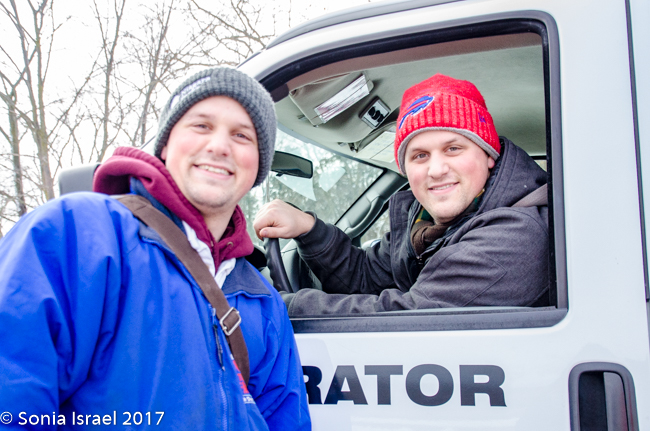 Over the Falls. A family affair! We drove off and headed to Goat Island (once called Iris Island), which separates the American and Bridal Veil Falls from the Horseshoe Falls. There are no goats on Goat Island. So why the name? John Stedman, an early pioneer and miller, kept a herd of goats on the island. Upon returning to the island after the terrible winter of 1780, Stedman found all but one of the goats had died, thus giving the island its name. Some in fact call it “Lucky Goat Island” for the one survivor.
Over the Falls. A family affair! We drove off and headed to Goat Island (once called Iris Island), which separates the American and Bridal Veil Falls from the Horseshoe Falls. There are no goats on Goat Island. So why the name? John Stedman, an early pioneer and miller, kept a herd of goats on the island. Upon returning to the island after the terrible winter of 1780, Stedman found all but one of the goats had died, thus giving the island its name. Some in fact call it “Lucky Goat Island” for the one survivor.
As we left the car, again in the empty parking lot, we walked under an old stone arch, with the Indian seal of Niagara on it. This is the arch that once stood at the original Adams Plant Transformer House, an electric generating station which harness the power of the water. This was part of the first large-scale AC electric generating plant in the world.
From here we could look down at Luna Island (closed in the winter). We could see the American Falls and Bridal Veil, as well as Horseshoe falls, from a different perspective. And we could admire the Tesla Monument, a gift from Yugoslavia in 1976, honoring the Servian-American inventor, electrical engineer, mechanical engineer, physicist and futurist, Nicola Tesla, who is best known for his contributions to the design of alternating current (AC) electrical supply. He, along with George Westinghouse, built the first major hydroelectric power plant in Niagara Falls and started the electrification of the world. The statue is of him sitting down and holding a large book, which looks gold as the finish has worn off from all the children (and likely adults) sitting on it for pictures. Today however, it was more covered with snow than people.
The island had fields of snow and we were tempted to just run through them. A jet black squirrel was darting about. There was the empty bench every so often, facing the water. I imagined that in the summer people would be picnicking and fighting over the benches. But today it was quiet in an ethereal way.
Three Sisters Islands
Our next stop was the Three Sisters Islands, where we could get a great view of the Upper Rapids before they cascade over the Horseshoe Falls. These are three islands connected to each other by foot-bridges. We walked over a larger stone bridge, covered in snow, with a stream below it. The island is covered in trees, although this time of year the branches were covered in snow rather than leaves. And there were what seemed like hundreds of seagulls and ducks just floating on the turbulent water.
So who were the three sisters? Celinda, Angelina, and Asenath Whitney, daughters of General Parkhurst Whitney, one of the earliest settlers in Niagara Falls. The girls are believed to be the first settlers to have trekked to the three small islands. Before 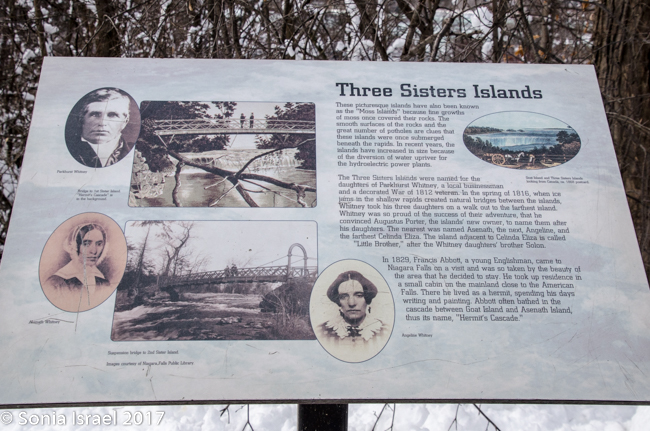 European settlers arrived in North America, Iroquois shamans made sacrifices of food and gifts on the islands and communed with He-No (Mighty Thunderer), the spirit who dwells in the mist-enshrouded cave at the base of the falls. Modern day psychics believe anyone can hear the voices of the spirits if they listen carefully while visiting the Three Sisters Islands.
European settlers arrived in North America, Iroquois shamans made sacrifices of food and gifts on the islands and communed with He-No (Mighty Thunderer), the spirit who dwells in the mist-enshrouded cave at the base of the falls. Modern day psychics believe anyone can hear the voices of the spirits if they listen carefully while visiting the Three Sisters Islands.
Rainbow Bridge and the Canadian Side
And then it was time to cross over to the Canadian side of the falls. We got back into the warm car and made our way through the town, past a small Statue of Liberty, to the Rainbow Bridge, officially called the Niagara Falls International Rainbow Bridge. This is an arch bridge which goes across the Niagara River Gorge and replaced the Honeymoon Bridge which collapsed in 1938 when ice jammed in the river.
Halfway across the bridge, right at the border, are two flags, the American on our side and the Canadian on the other, and that is the exact border. Calab stopped the car right at the door to immigration and we stepped out to show our passports. We were once again so grateful that there were no lines. We got back into the car and drove past a tower just on the Canadian side, with an engraving with the biblical quote from the chapter of Noah from the Old Testament book of Genesis referring to the “bow in the clouds.”
Nicola Tesla and King George VI
This side of the falls was much more crowded. While the American side gets about 8 million visitors a year, the Canadian side gets closer to 20 million. This past year there were a total of 35 million visitors total. We drove past another statue of Tesla, the only one with statues on both sides. There is also a statue of King George VI who visited Niagarah Falls with Queen Elizabeth in 1939. The 10 foot high granite statue shows the King wearing full military regalia; including a large floor length cape, sash, brocaded high collar shirt, various medals. A rope with huge tassels hangs from his neck and he is holding the hilt of a sword with his left hand. We made our way to the parking lot near the Table Rock Welcome Center. The Canadian side is so much more built up. While the American side is quiet and full of trees, the Canadian side seems more for entertainment. Zip lines. Activities. Lots of hotels (turns out there is a law on the American side that no buildings – private homes or hotels – can be built with a view of the falls). And the large Skylon Tower.
Table Rock
Table Rock was a large shelf of rock that jutted out from the Canadian shore of Niagara Falls just north of the Welcome Center. It was blasted off after several rockfalls to make the place safer for tourists. The Ta ble Rock Welcome Center is full of fast food and shops, but the bathrooms were clean and it is the way out to see Horseshoe Falls. There is also a 4D movie, but we opted to just see the real thing. Our first stop was down the elevator to the tunnels under the building, to Journey Behind the Falls.
ble Rock Welcome Center is full of fast food and shops, but the bathrooms were clean and it is the way out to see Horseshoe Falls. There is also a 4D movie, but we opted to just see the real thing. Our first stop was down the elevator to the tunnels under the building, to Journey Behind the Falls.
Journey Behind the Falls
The elevator took us down 125 feet. We exited into the start of the 130-year old tunnels cut through the bedrock. We could hear the roar of the water and feel the thunderous vibration way before we saw the falls. We walked through the tunnels, stopping periodically to read the posters describing all aspects of the falls (including how the tunnels were built, description of Table Rock, the Miracle of Niagara, those that tried to barrel over the falls, famous visitors etc), and made our way to the portals cut through the rock to stand right behind the falls. The water cascaded down just outside the window, often being blown back into the tunnel, right at us. We were told this was one-fifth of the world’s fresh water crashing down in front of us. It was so loud. It felt so powerful. It was stunning. And from some of the windows we could also look out and see the falls themselves, along with the ice and snow. There is also an observation deck but it is closed in winter.
After gazing at the back of the Horseshoe Falls, it was time to ascend and see the falls from the outside.
Horseshoe Falls
The Horseshow Falls are the third of the falls and are on the border of the two countries with some of the falls on either side. The Horseshoe Falls drop about 188 feet and are about 2,600 feet wide. The Horseshoe falls are separated from the American Falls and Bridal Veil Falls by Goat Island.
While Iguazu Falls (see my blog on Iguazu) is larger, Niagara has the largest water flow, that is, more water coming over the top, and the most powerful as measured by flow rate. At its peak, more than six million cubic feet of water goes over the crest of the falls every minute. EVERY MINUTE! The flow is a direct function of the water level of Lake Erie so usually peaks in late spring or early summer.
We walked along the walkway which was filled with people, families with the children, friends, all bundled up, all with cameras (mostly phones) trying to take selfies with the falls behind them. We kept walking to try to find the best vantage point to see the full horseshoe. On the way we were asked by a group of young men to take their picture. One was local and the others were from other parts of Canada. I took their picture and then we chatted for a bit. When we said good-bye, they each shook our hands. I don’t think any American has ever done that!
We finally found the right spot and took our pictures. But mostly, we just stood there taking in the magnificence of the water, listening to the power, and looking for rainbows. Andy noticed one below us in the water. This seems to be our MO. The only rainbow we saw in Iguazu was also down in the water. But the day was not over yet.
The Keg at Embassy Suites
But now it was time for lunch. We had a reservation at The Keg, on the ninth floor of the Embassy Suites, overlooking the falls. We invited Caleb to join us and the three of us had a delightful lunch with incredible views. It was hard to take our eyes off the windows.
But eventually the food came and we happily ate. Caleb ordered the famous beef sandwich which looked like it had tons of meat in it.
Skylon Tower
I thought this was one of the most beautiful views of the falls we could have. But I was wrong. The most beautiful view was from the top of the Skylon Tower, our next stop. We took the 52 second ride up the yellow glass-enclosed elevator (called the Yellow Bug) to the observation deck 775 feet above the falls. There is also a revolving restaurant and other activities here, but we were here for the highest view of the falls as well as the views in the other direction, as far as Toronto. Andy stayed inside as it was cold and windy, but I ventured out to the outdoor deck where I could see the all three falls, the Great Gorge, the Rainbow bridge, Goat Island. I walked all the way around looking at the view in all directions. I loved it. I imagine it would also be beautiful at night with the city lights and the illumination of the falls.
My Rainbow
And then it was time to head back to Buffalo. But we had a bit of time, so Caleb drove back to the Table Rock Welcome Center as he was sure it was the right time of day to see a rainbow. And he delivered. The sun was out and at just the right angle to the falls and there were few clouds in the sky. And sure enough, there it was. A rainbow over Niagara Falls. Gorgeous. You could see each color. It was awe inspiring.
We crossed the Rainbow bridge again and the view of the falls with the sun going down was gorgeous. We again passed the flags, from Canada back to the US.
We went back through immigration (this time we did not need to leave the car), and headed back the way we came.
We passed the Peace Bridge, another international bridge where one can cross the border.
Final thoughts on Niagara Falls
We were so glad that we saw both sides of the falls. Some say the Canadian side is more beautiful. I think both sides are beautiful but in different ways. On the American side it seemed peaceful, quiet and the focus was the falls. On the Canadian side there is more entertainment, more to do, and you can spend the night looking at the falls. And you can see the full horseshoe of the Horseshoe Falls. They are different, but one is not better than the other. But don’t forget your passport!
